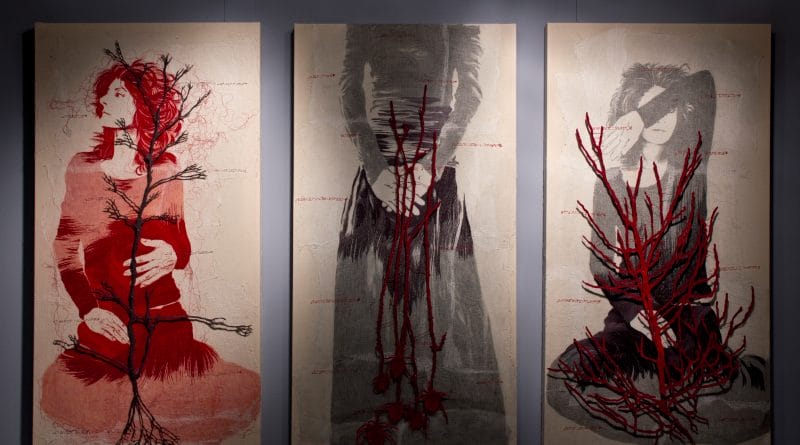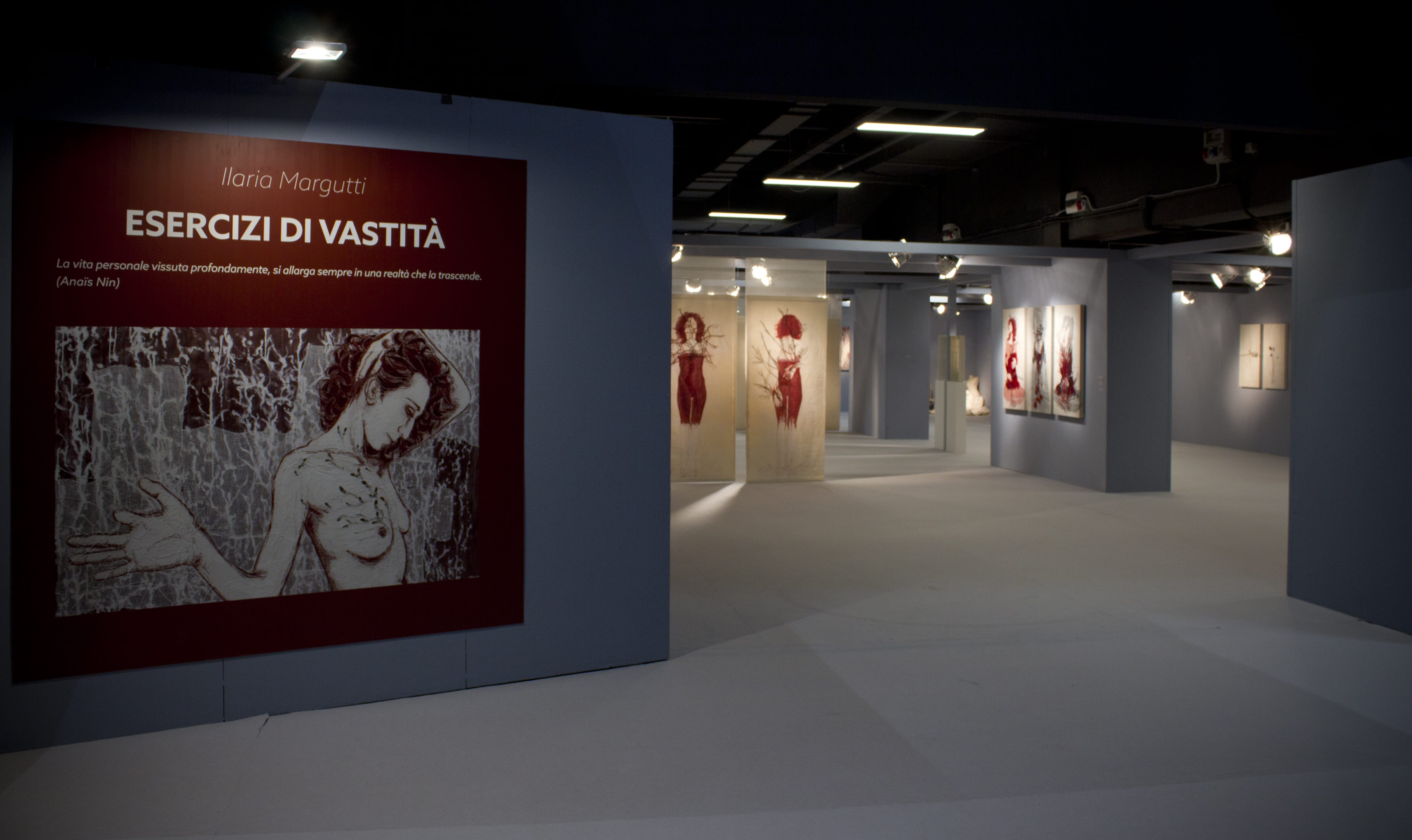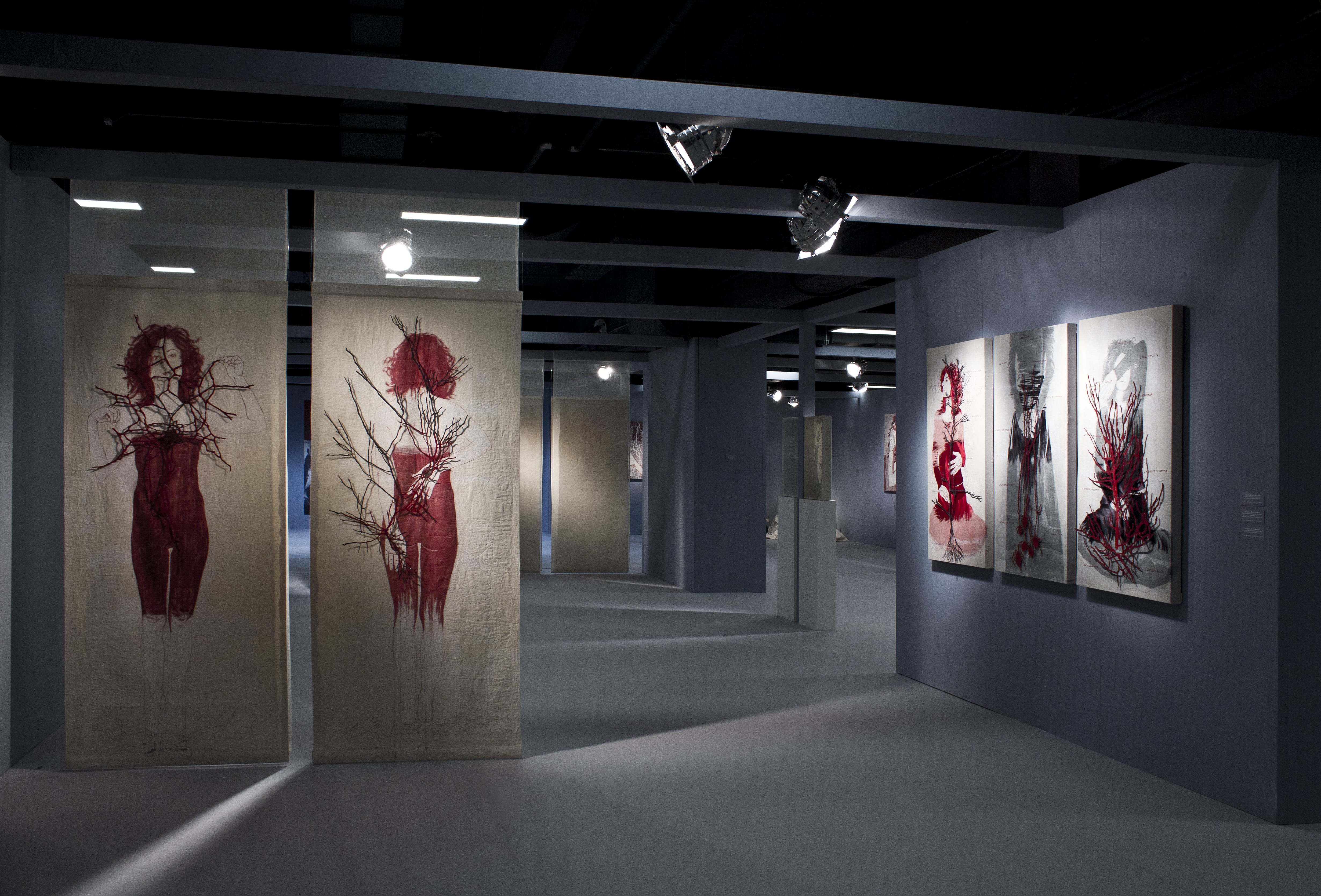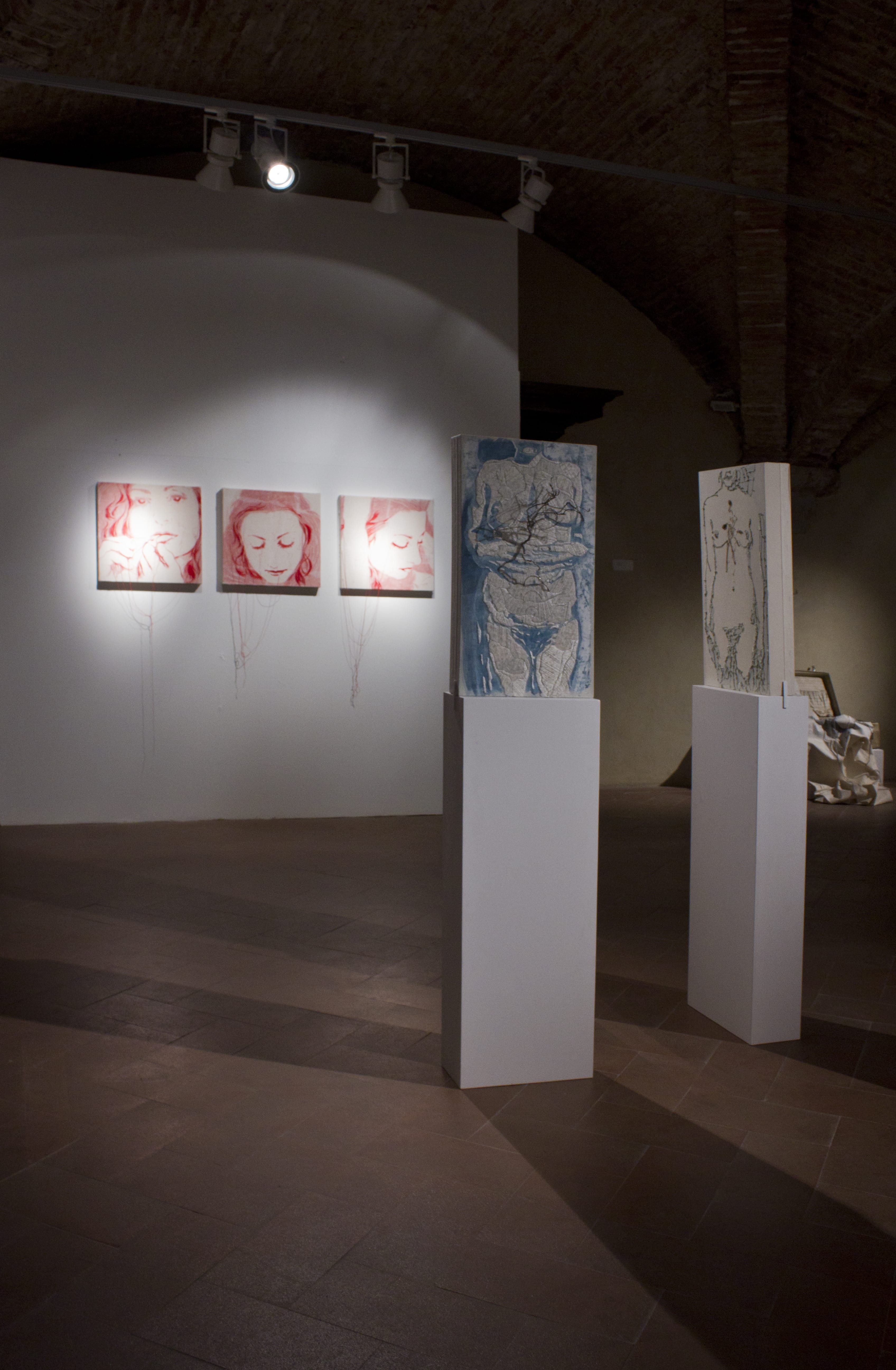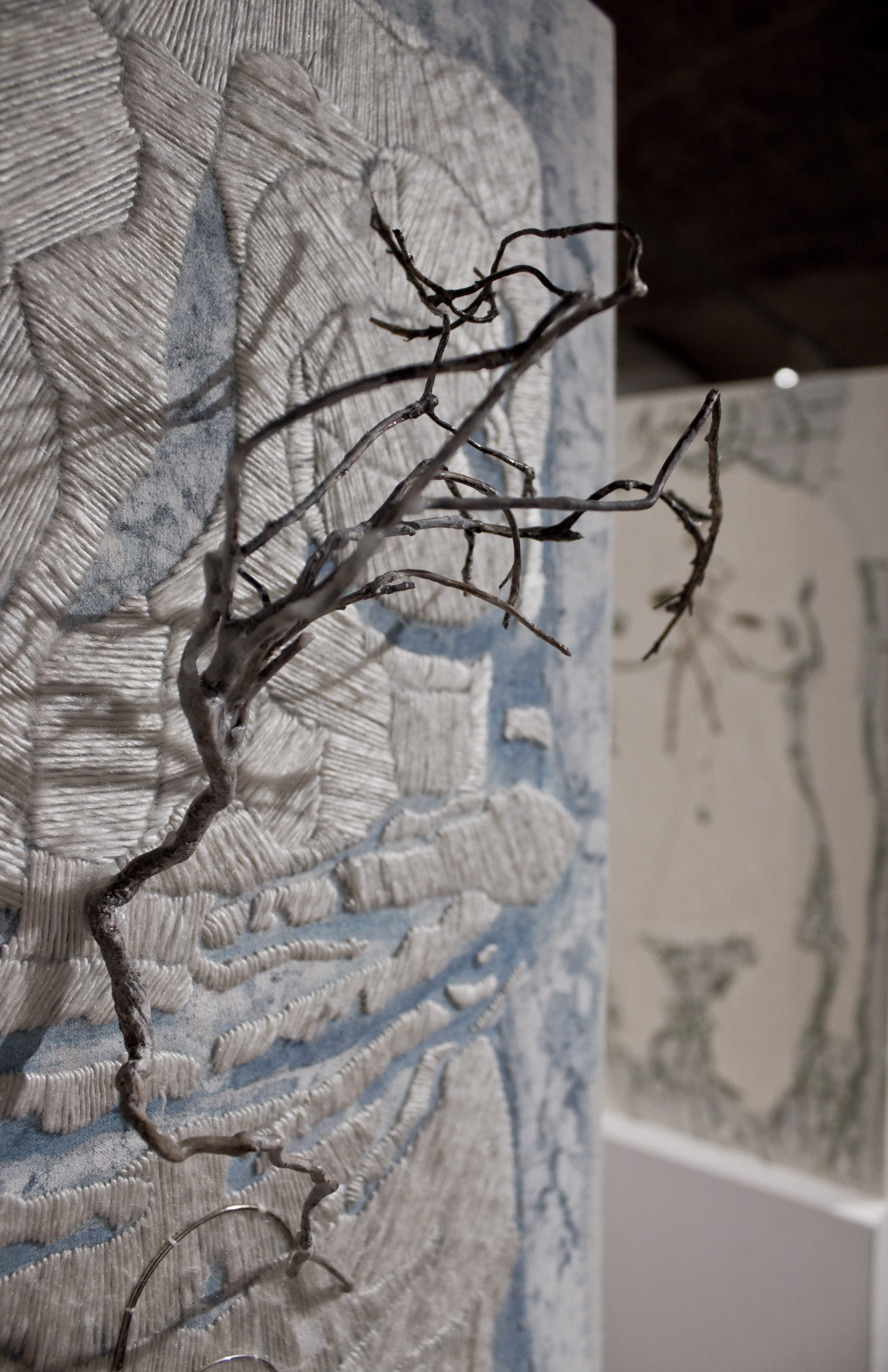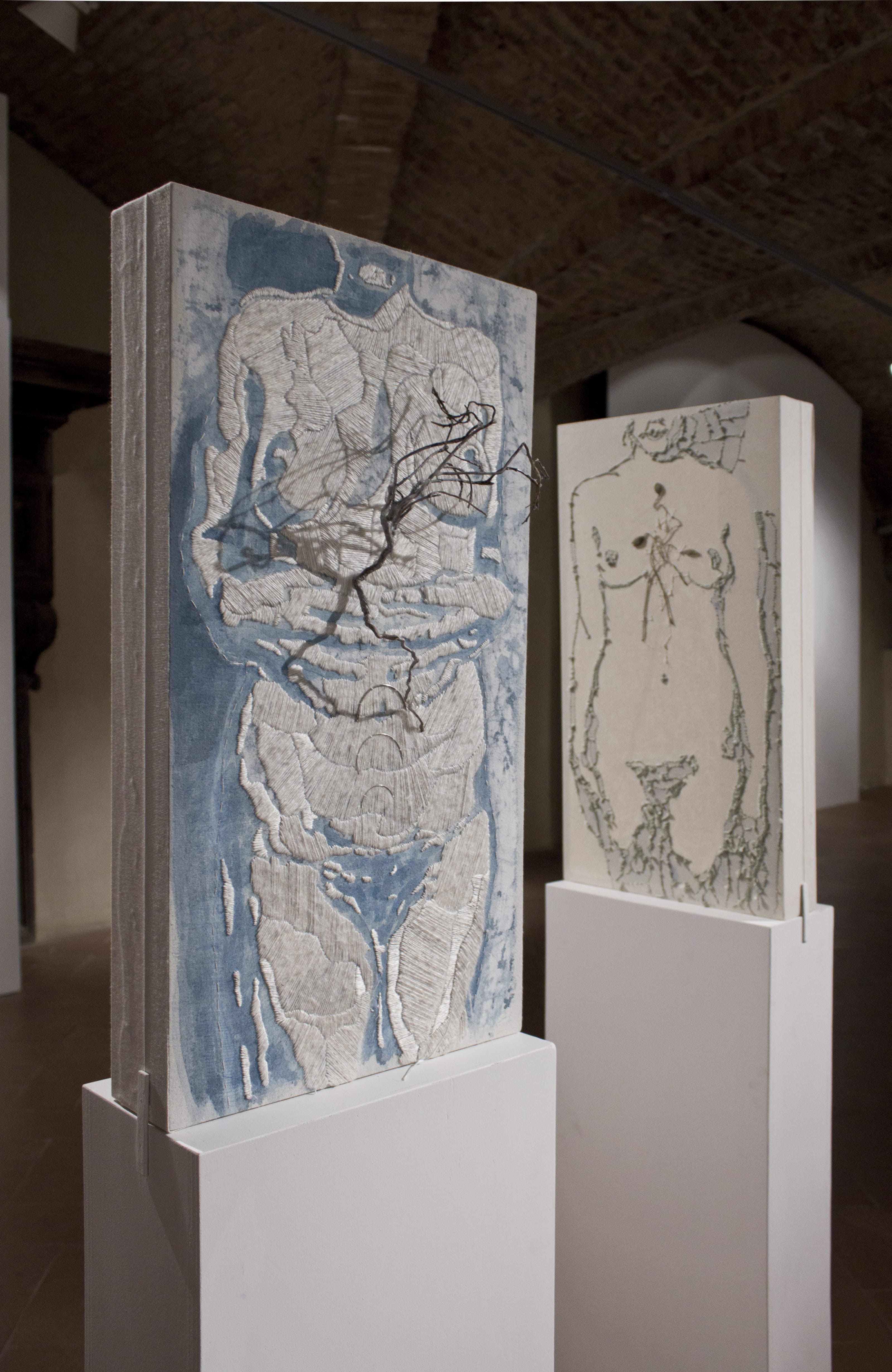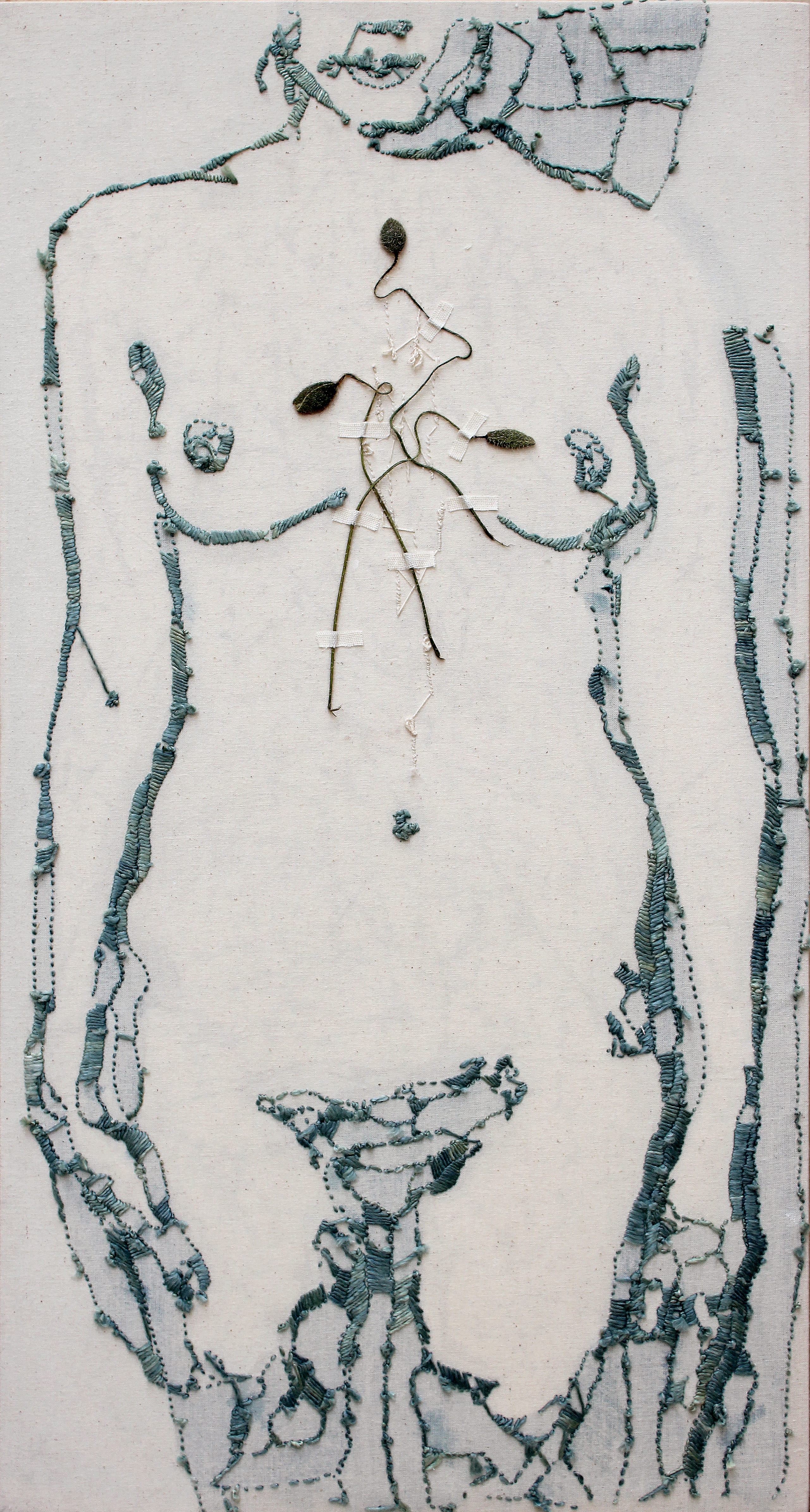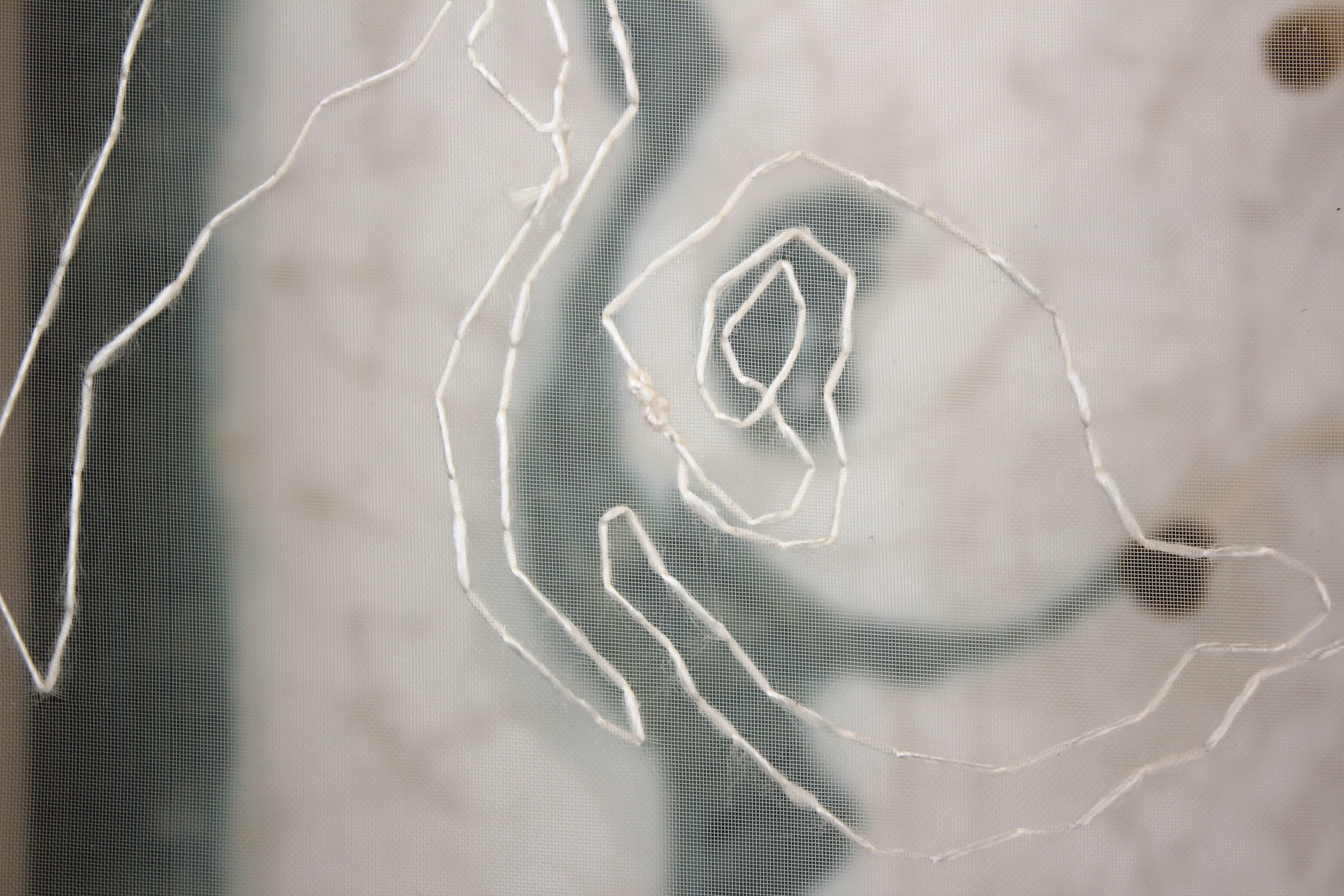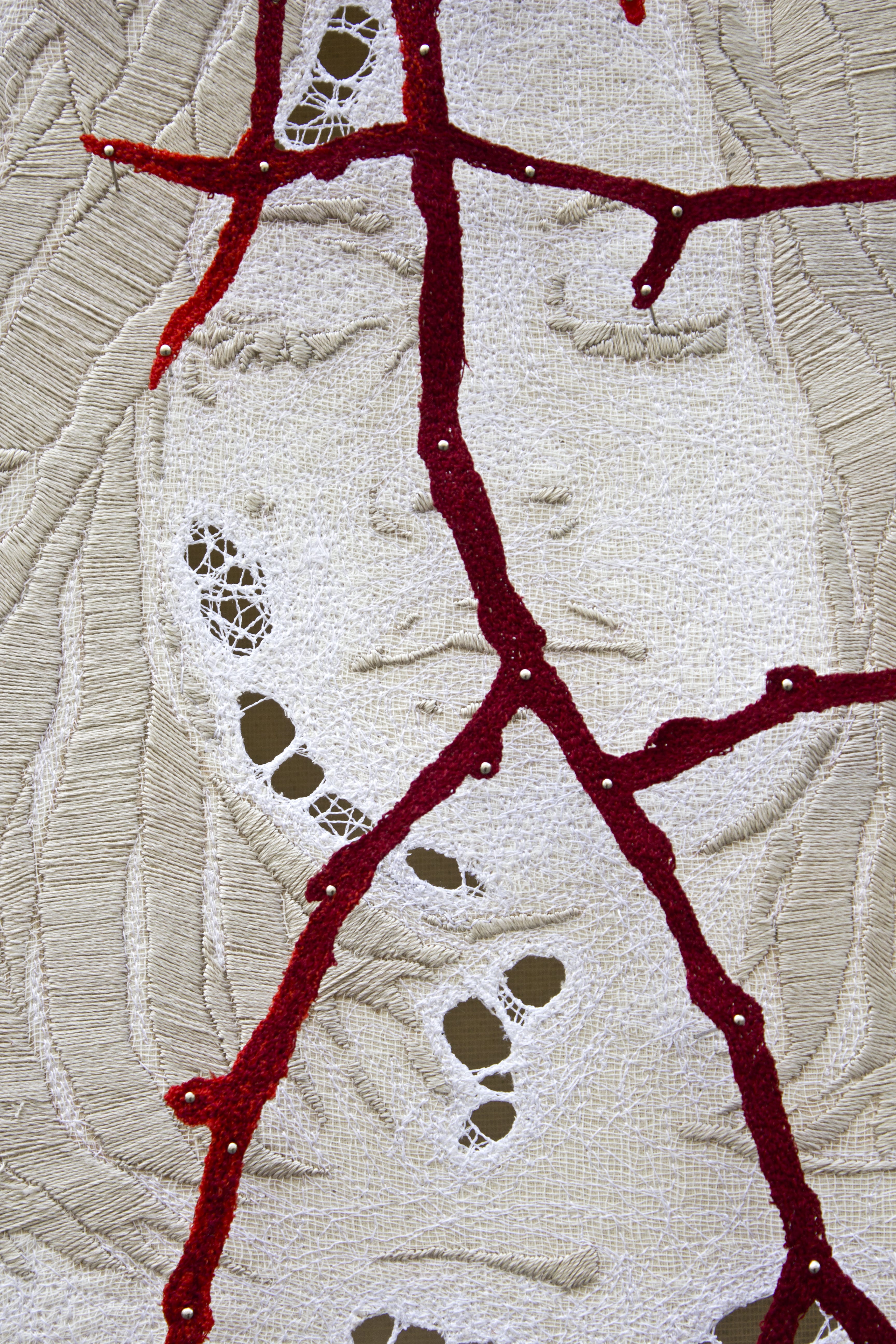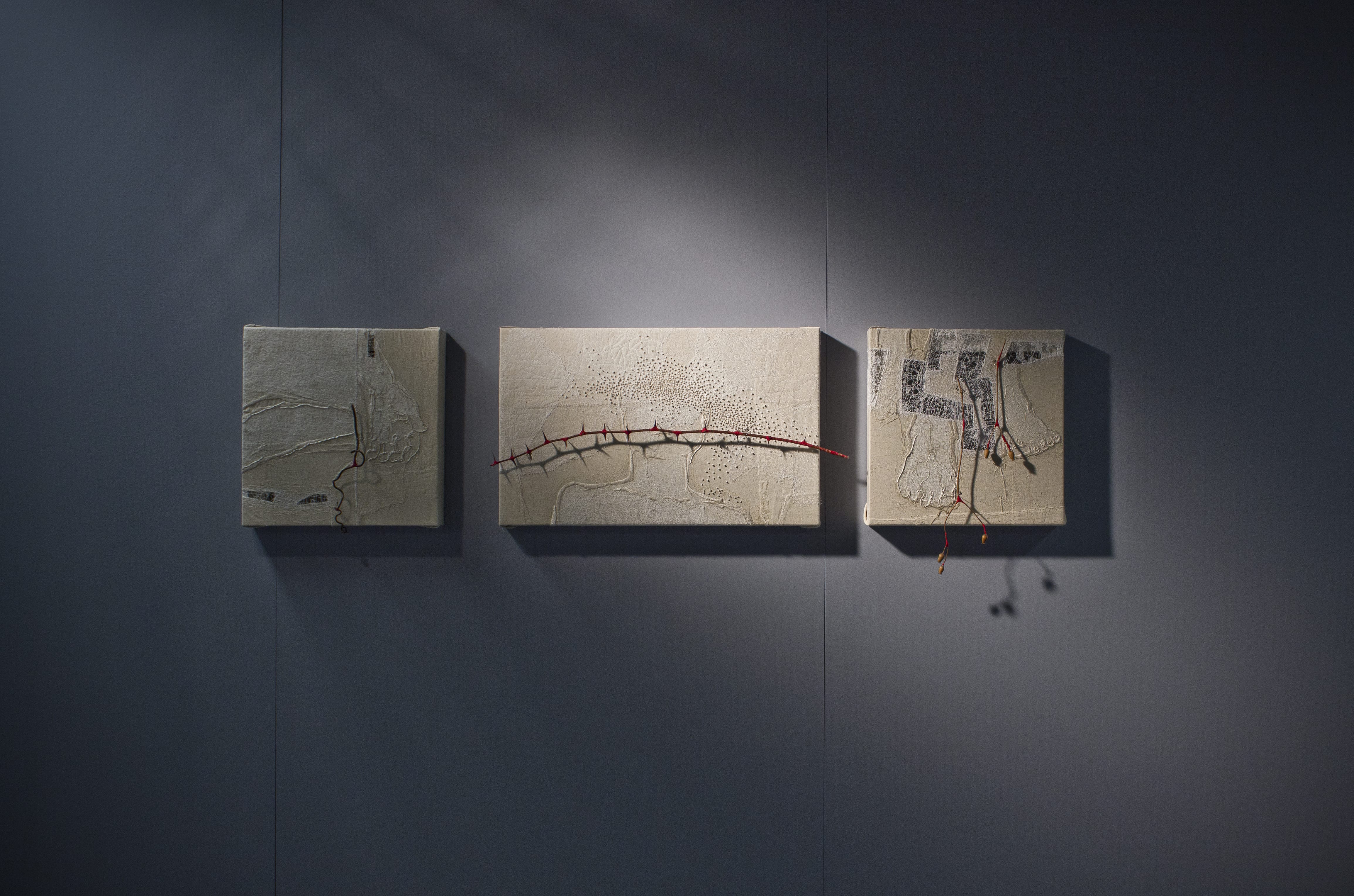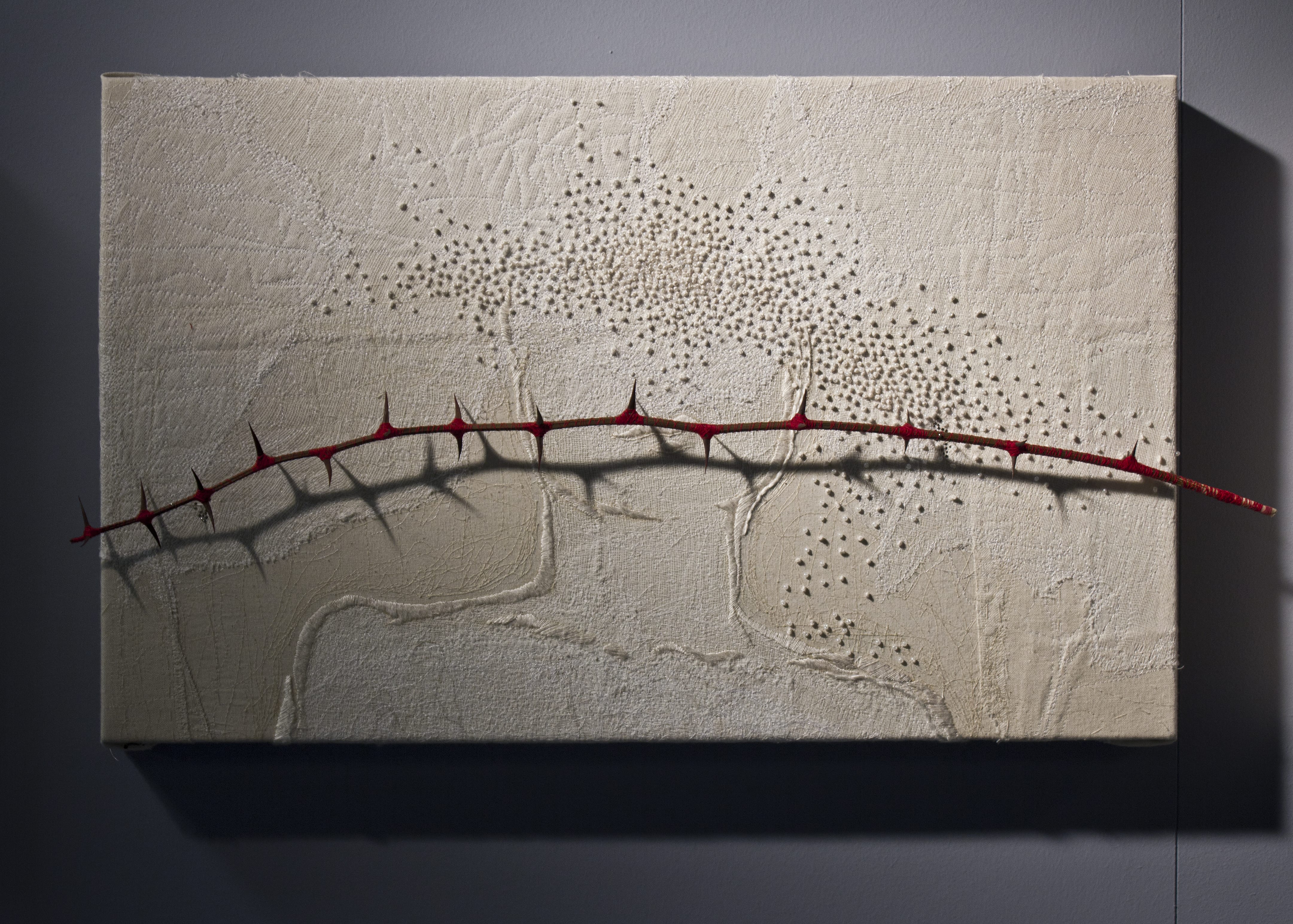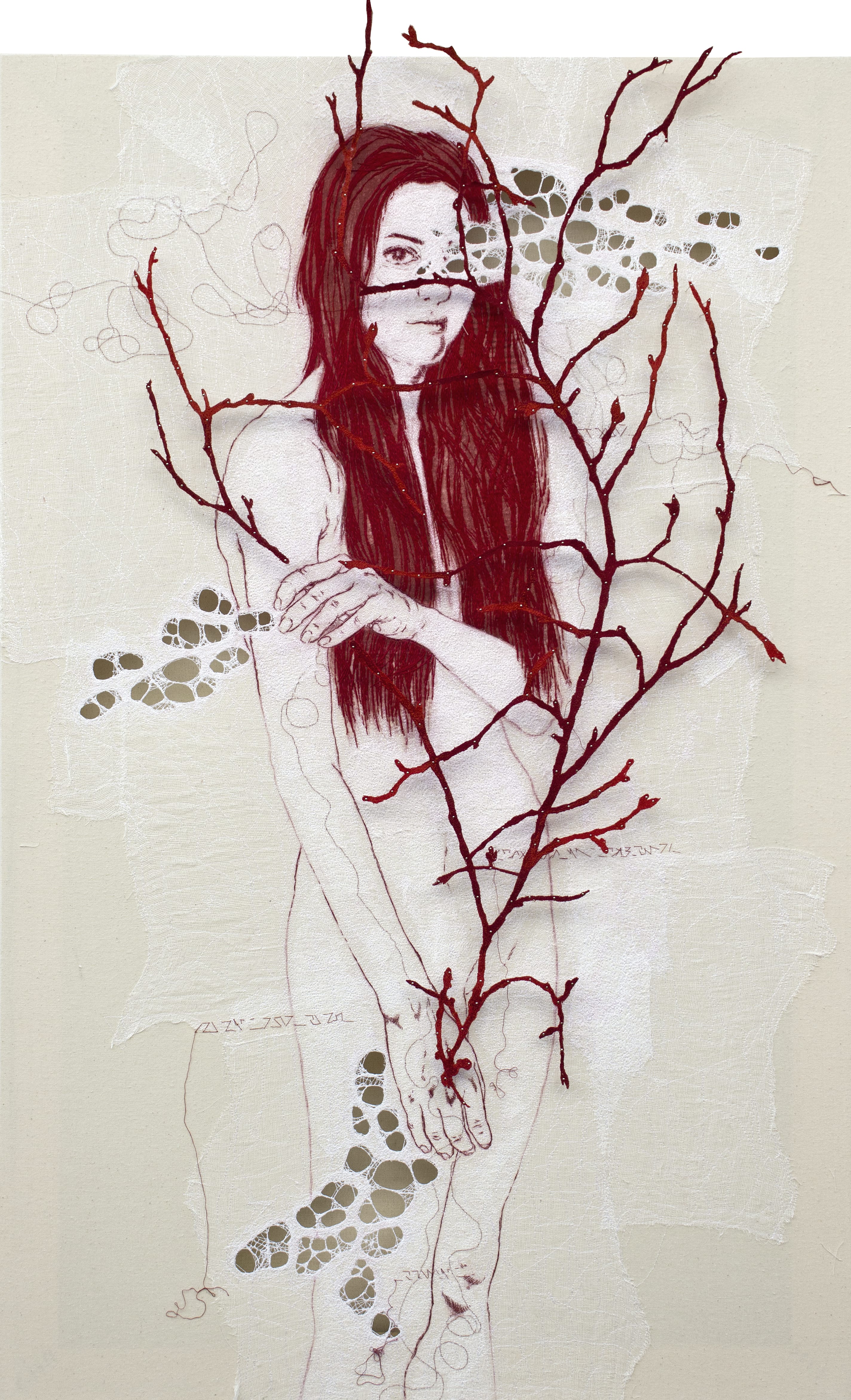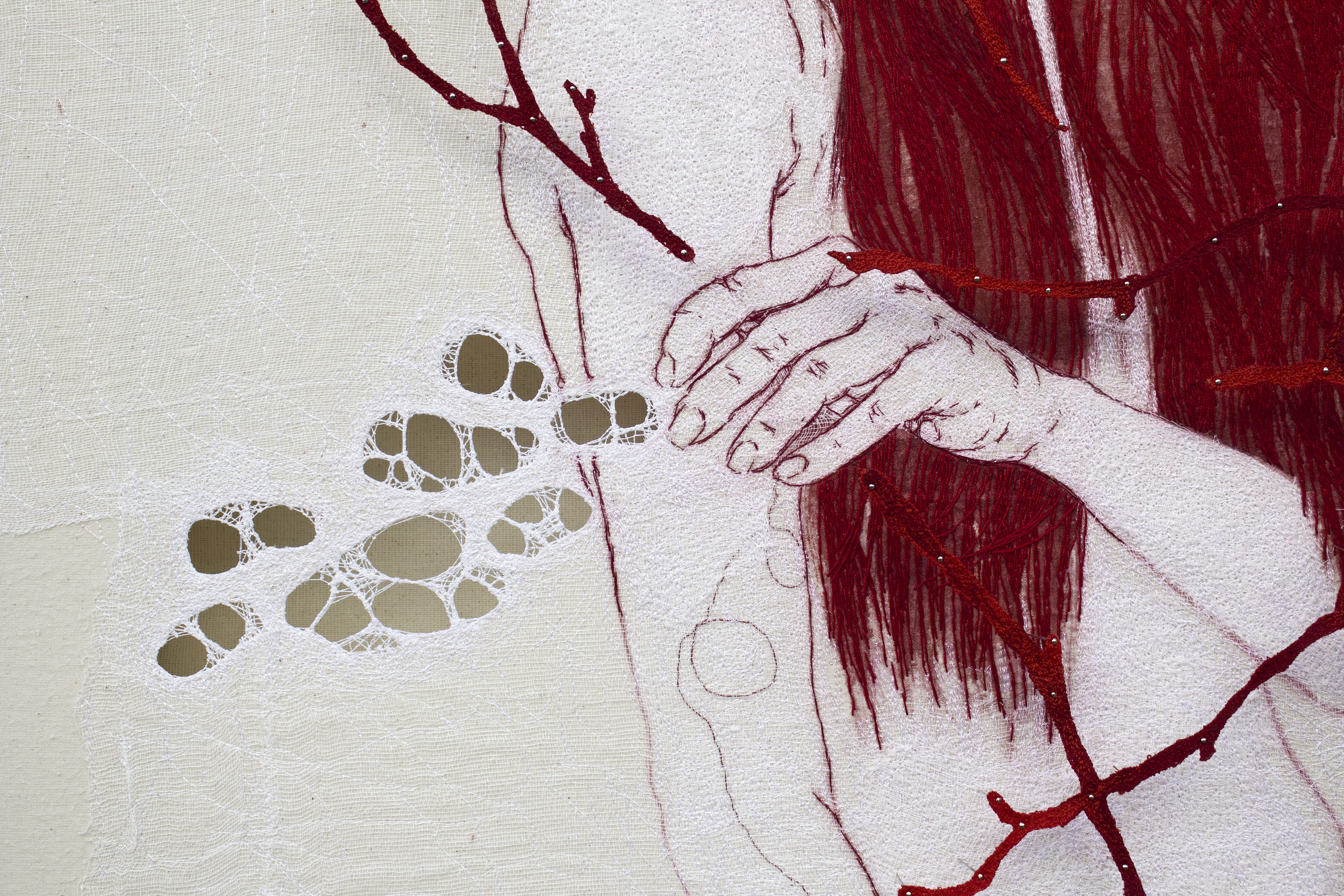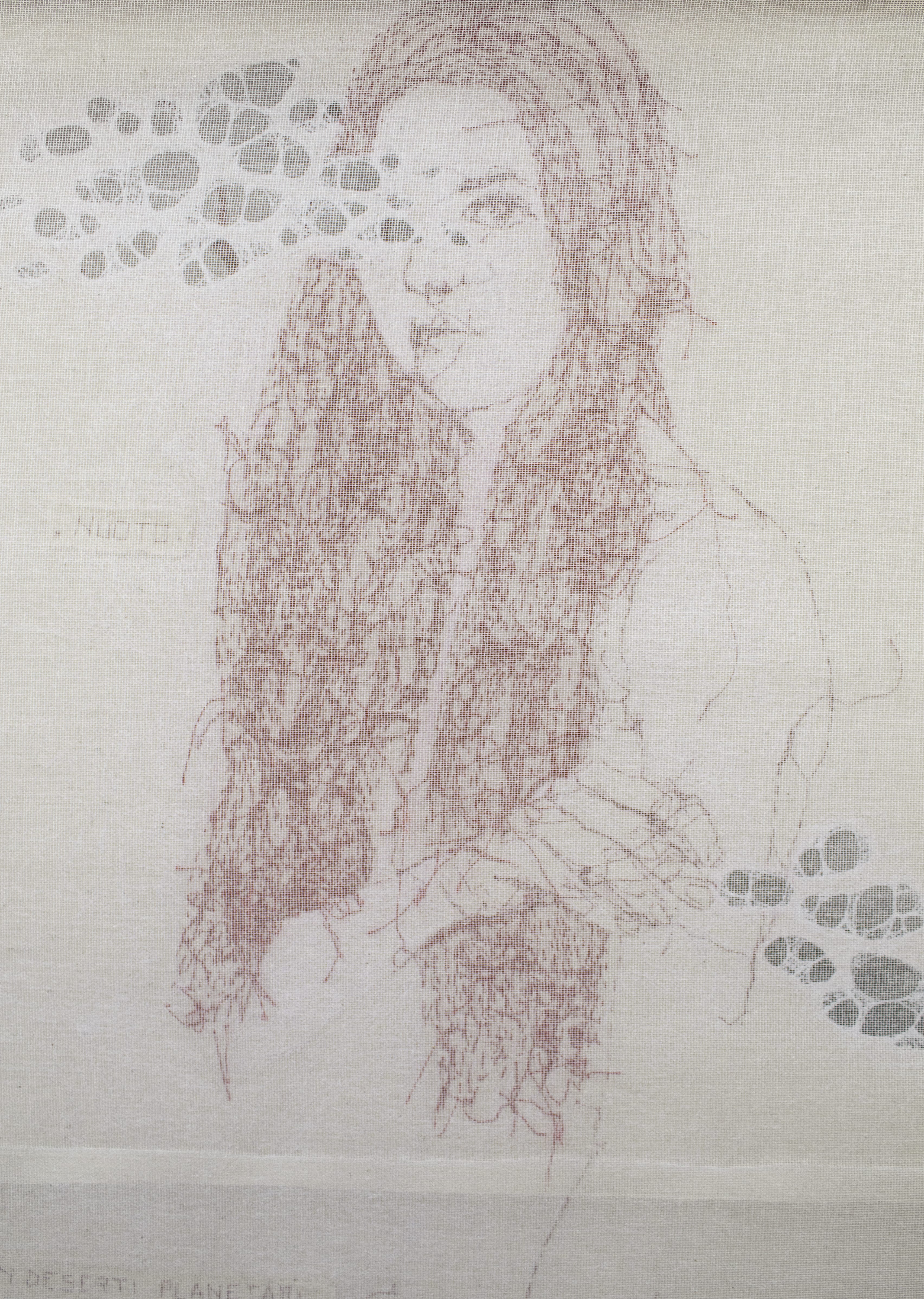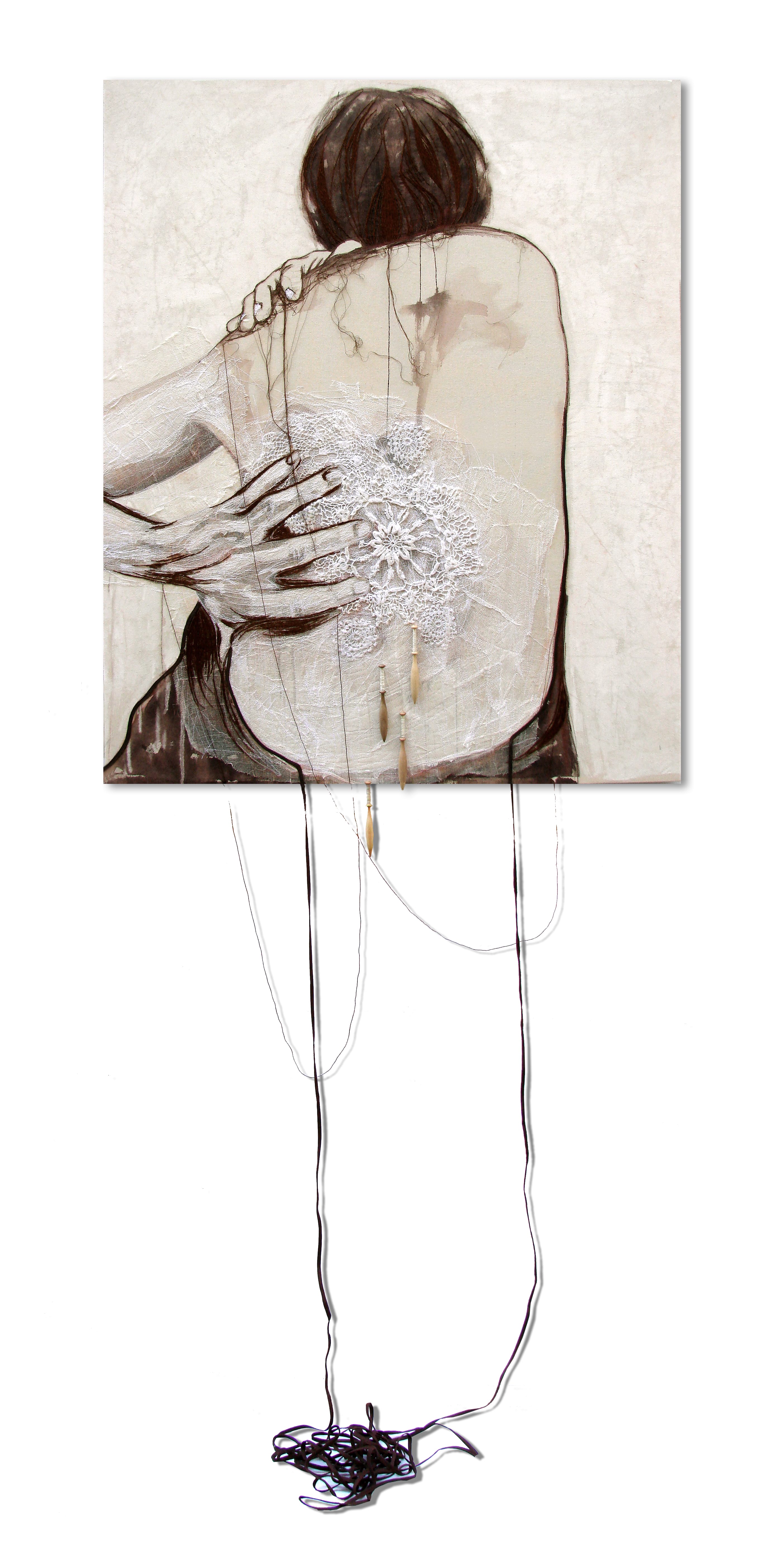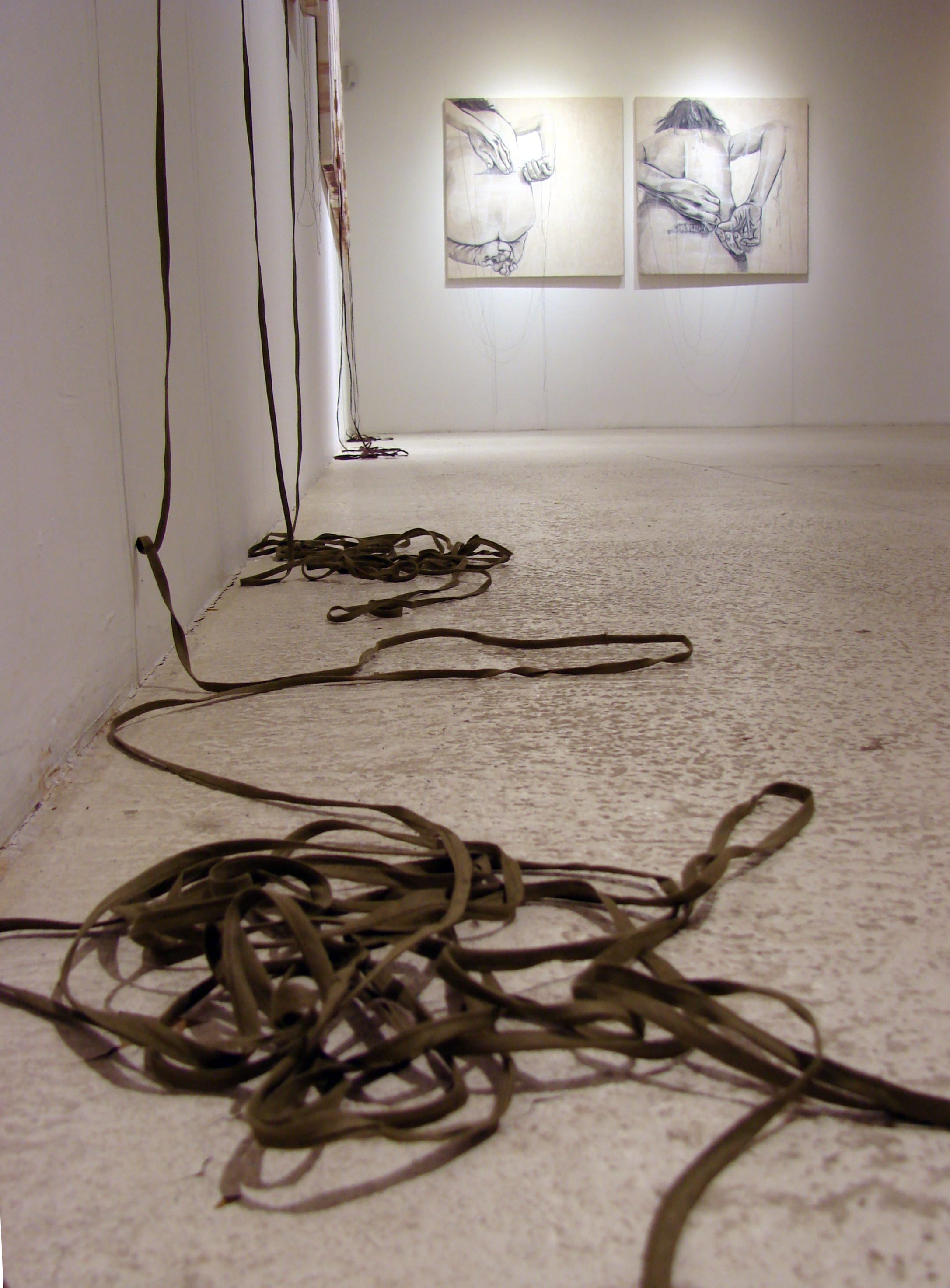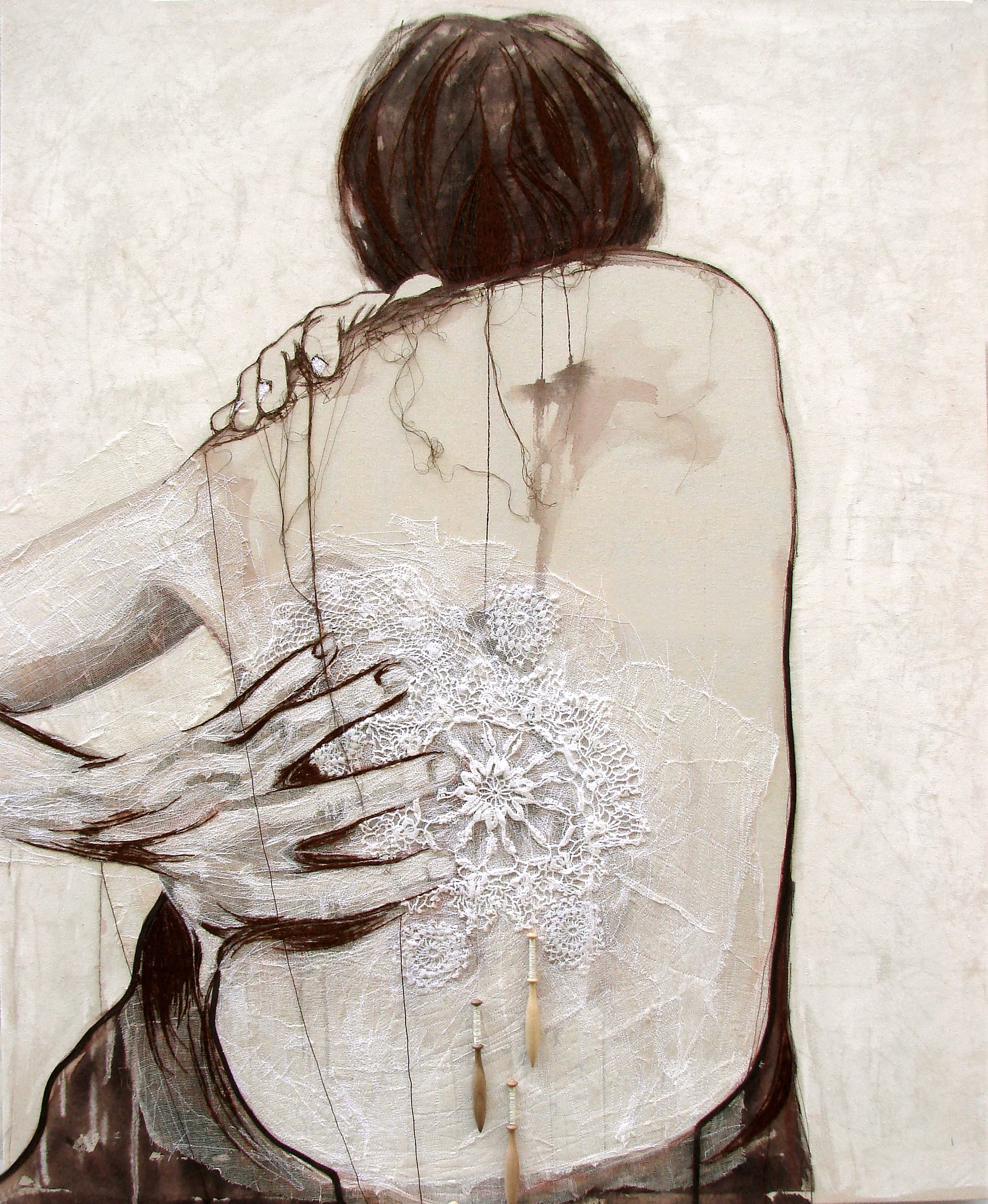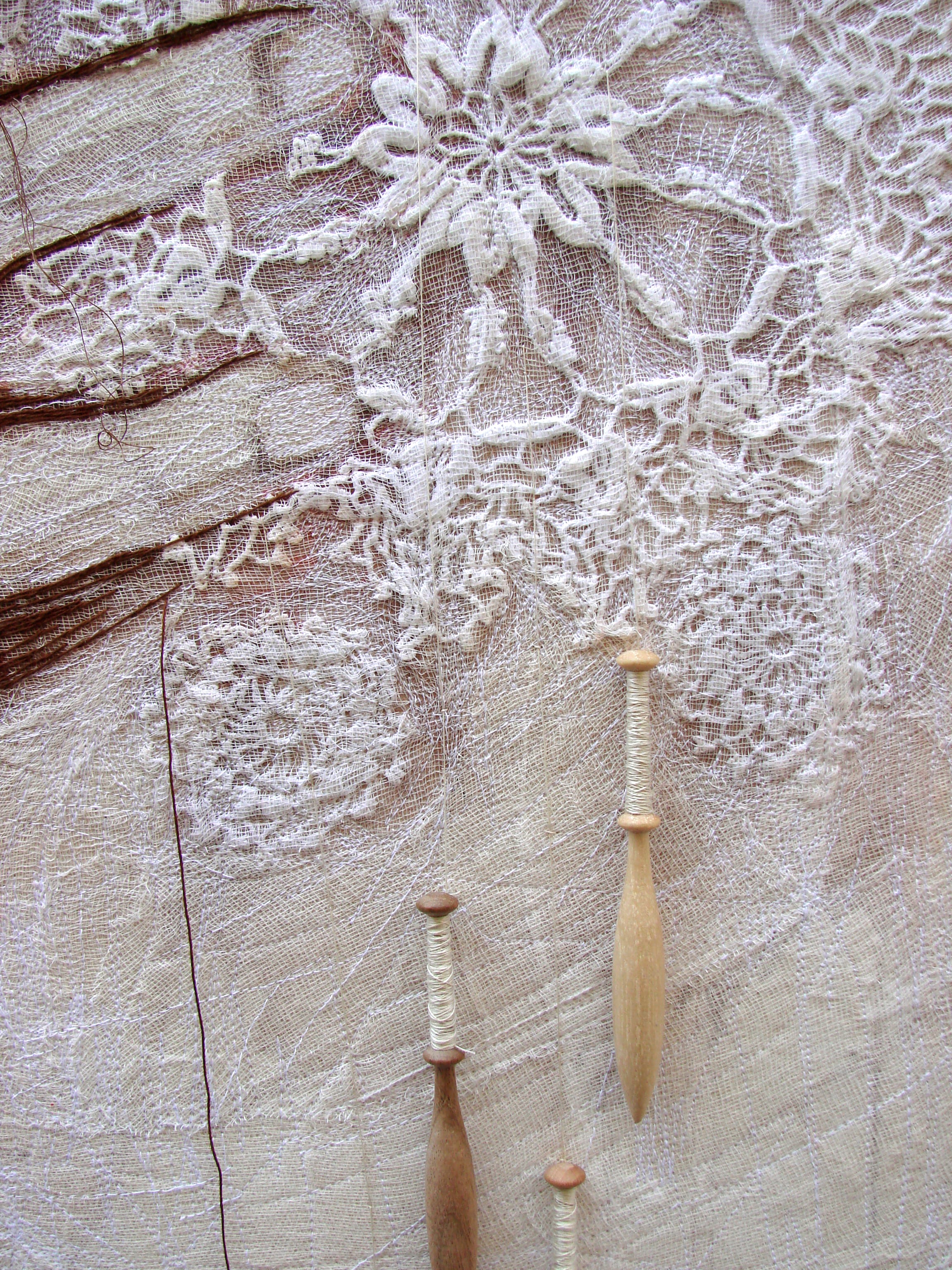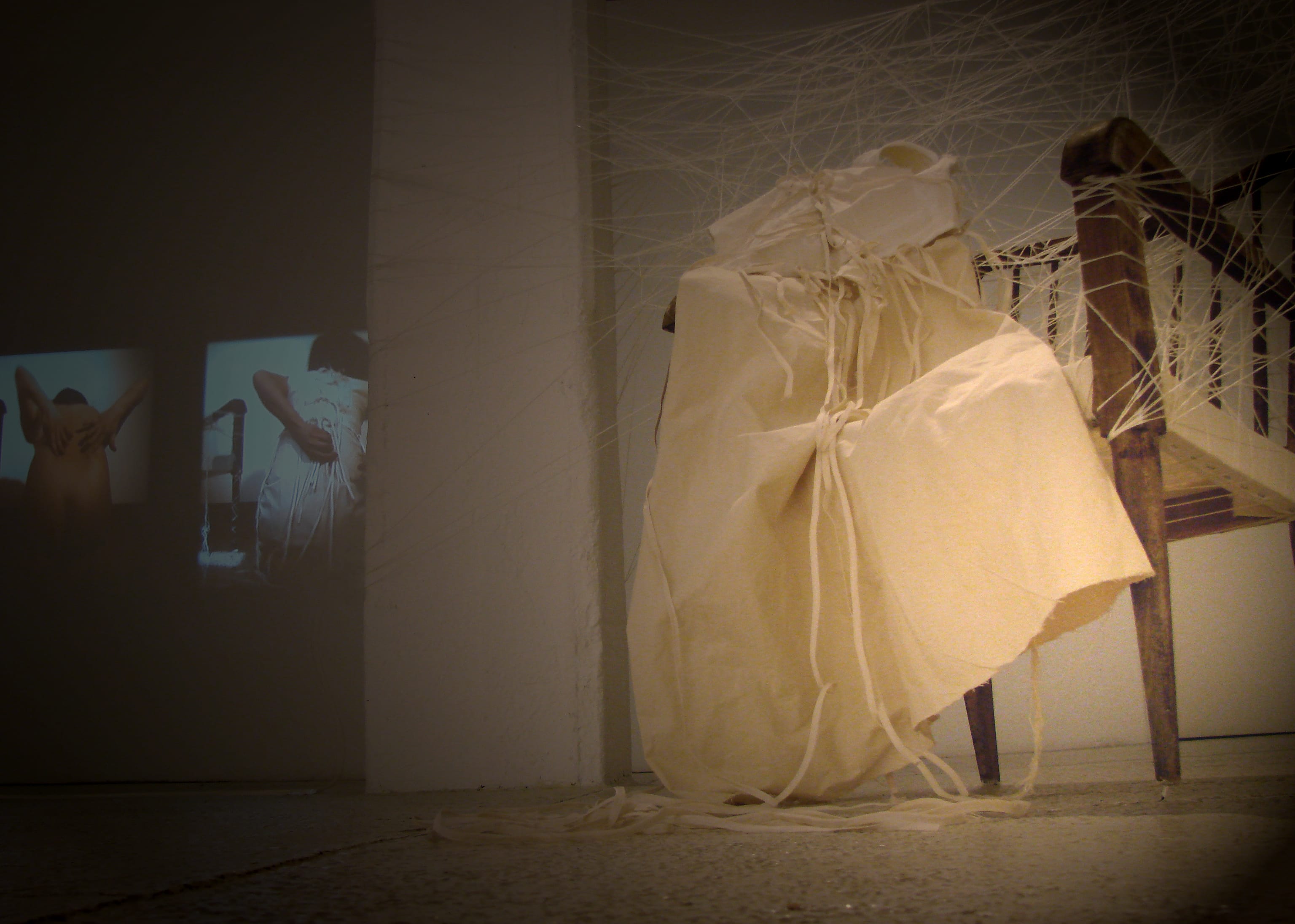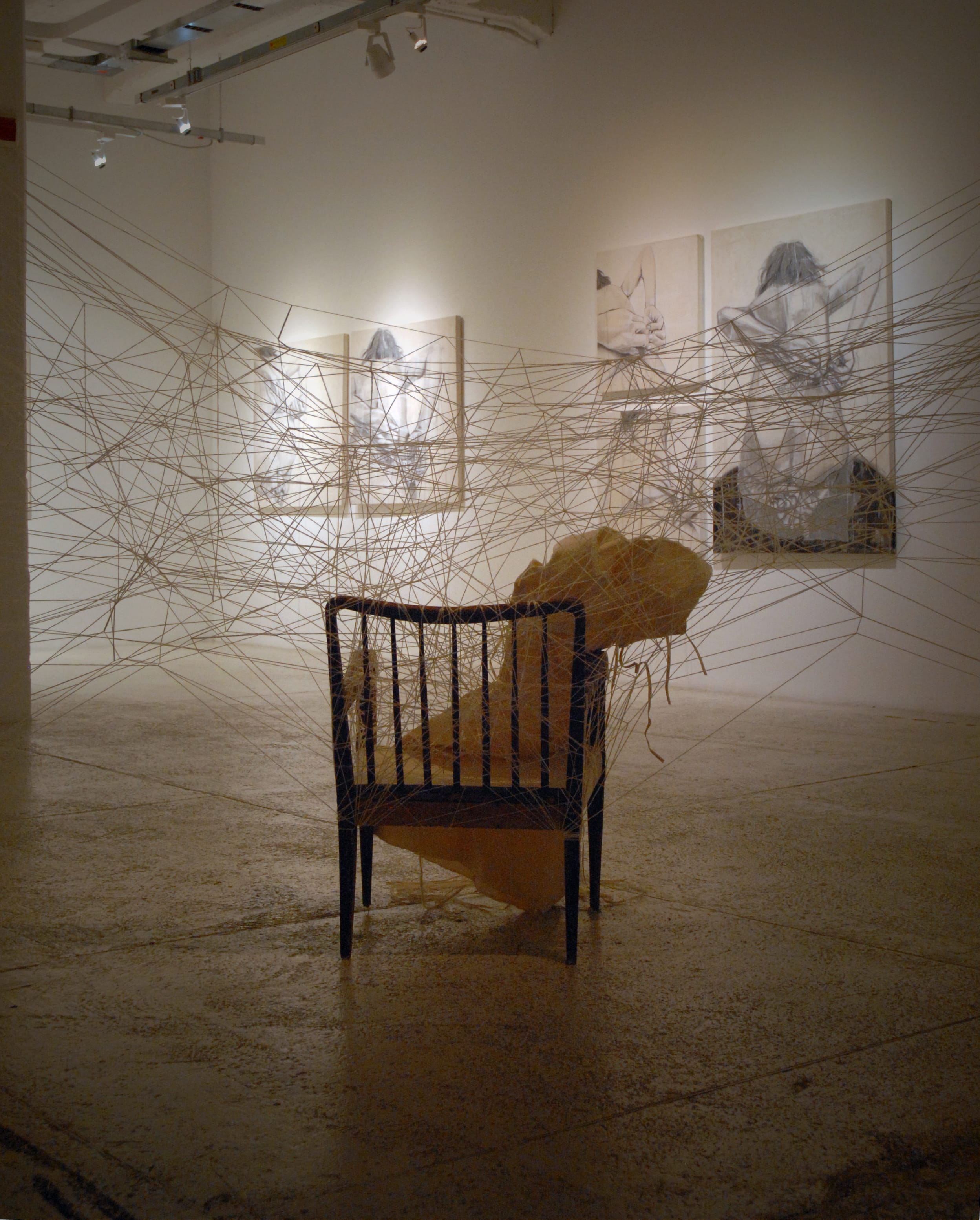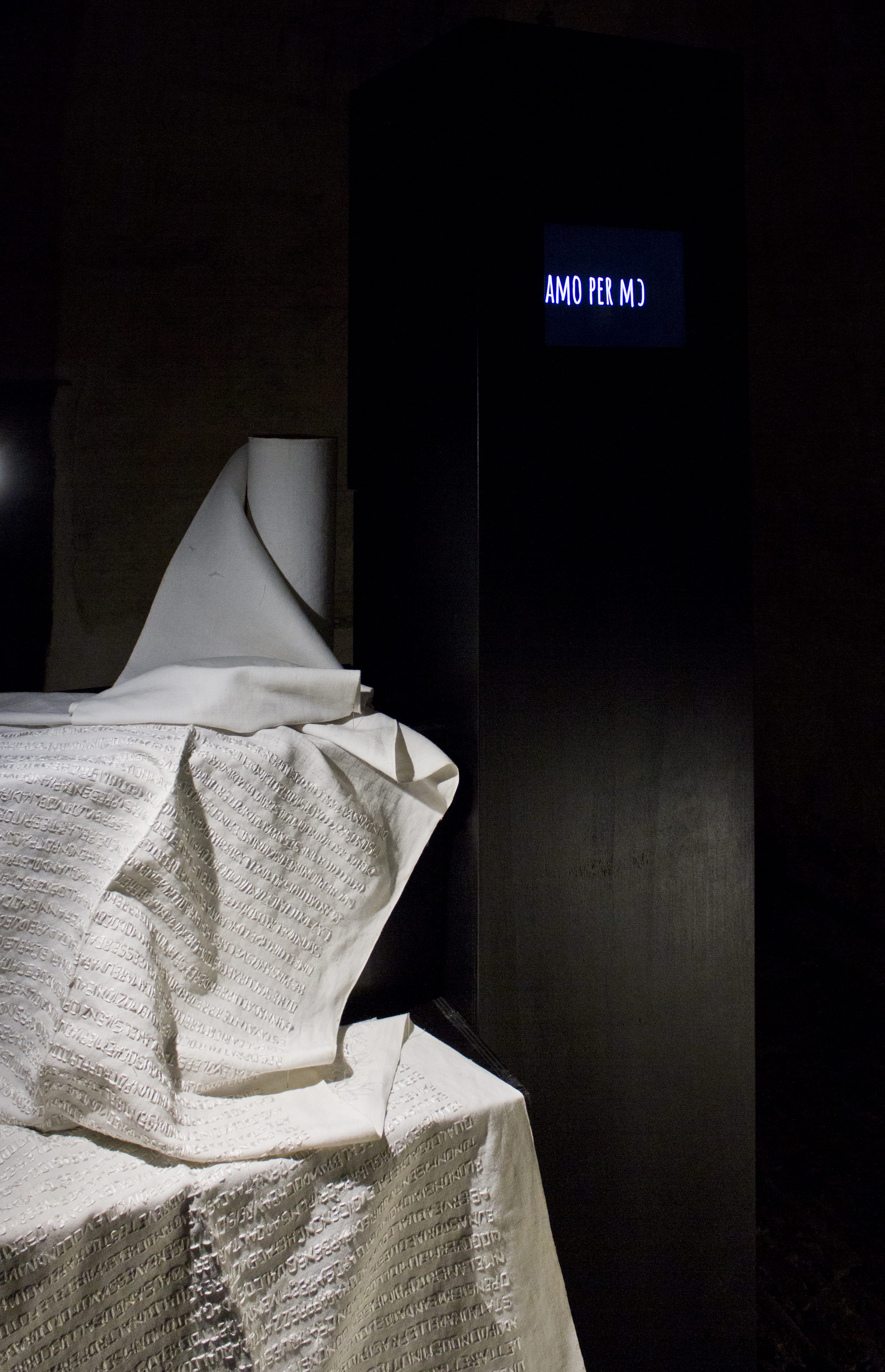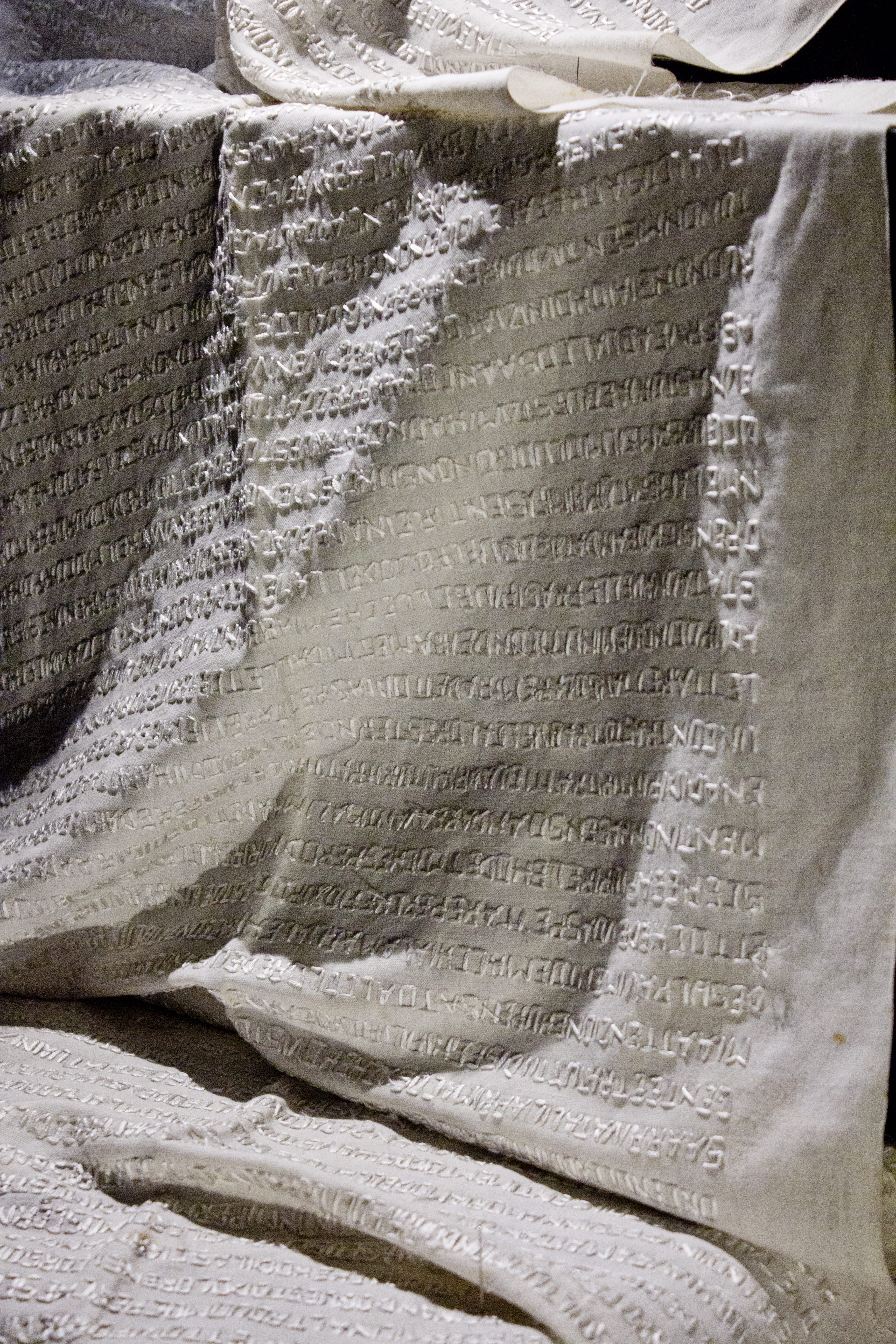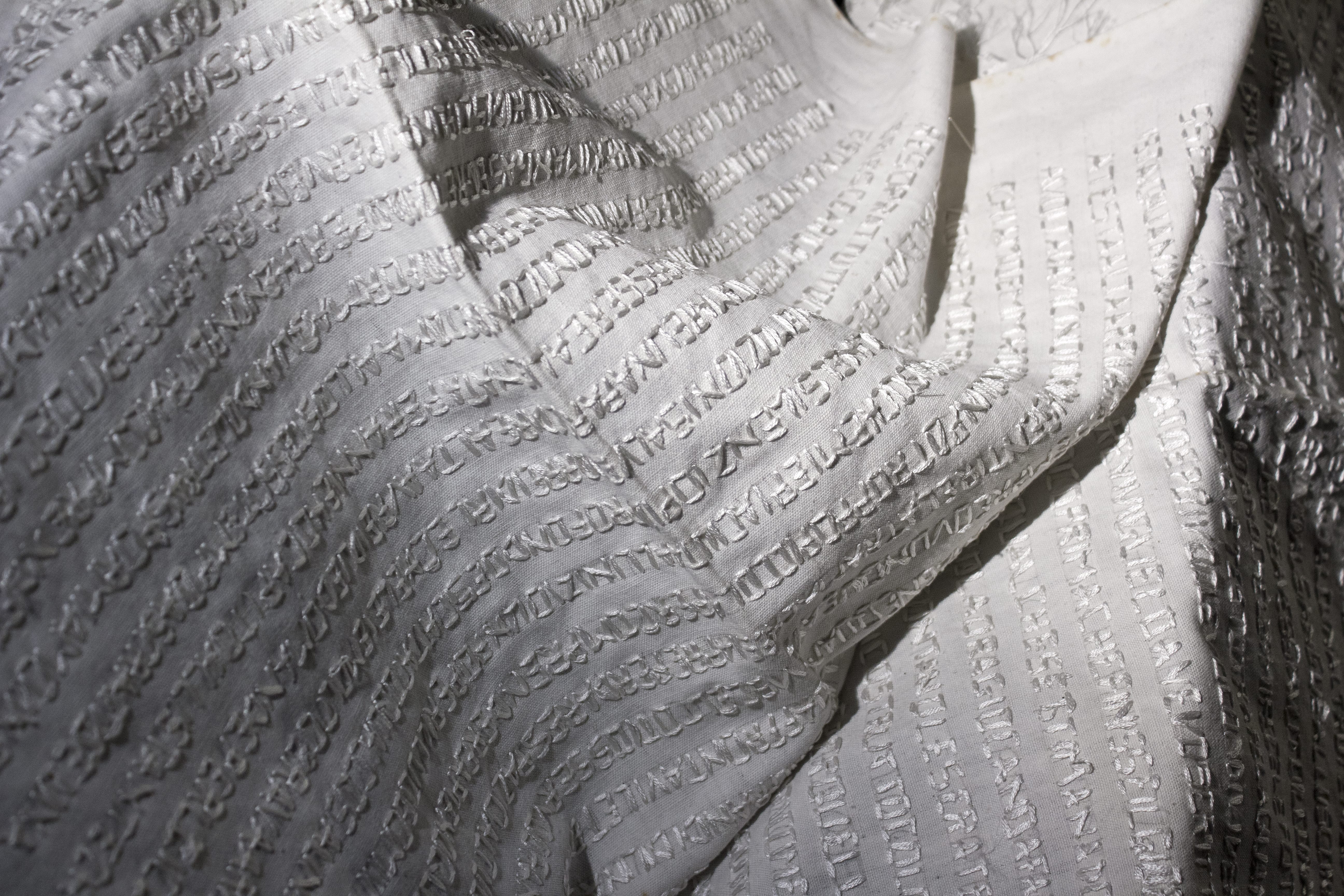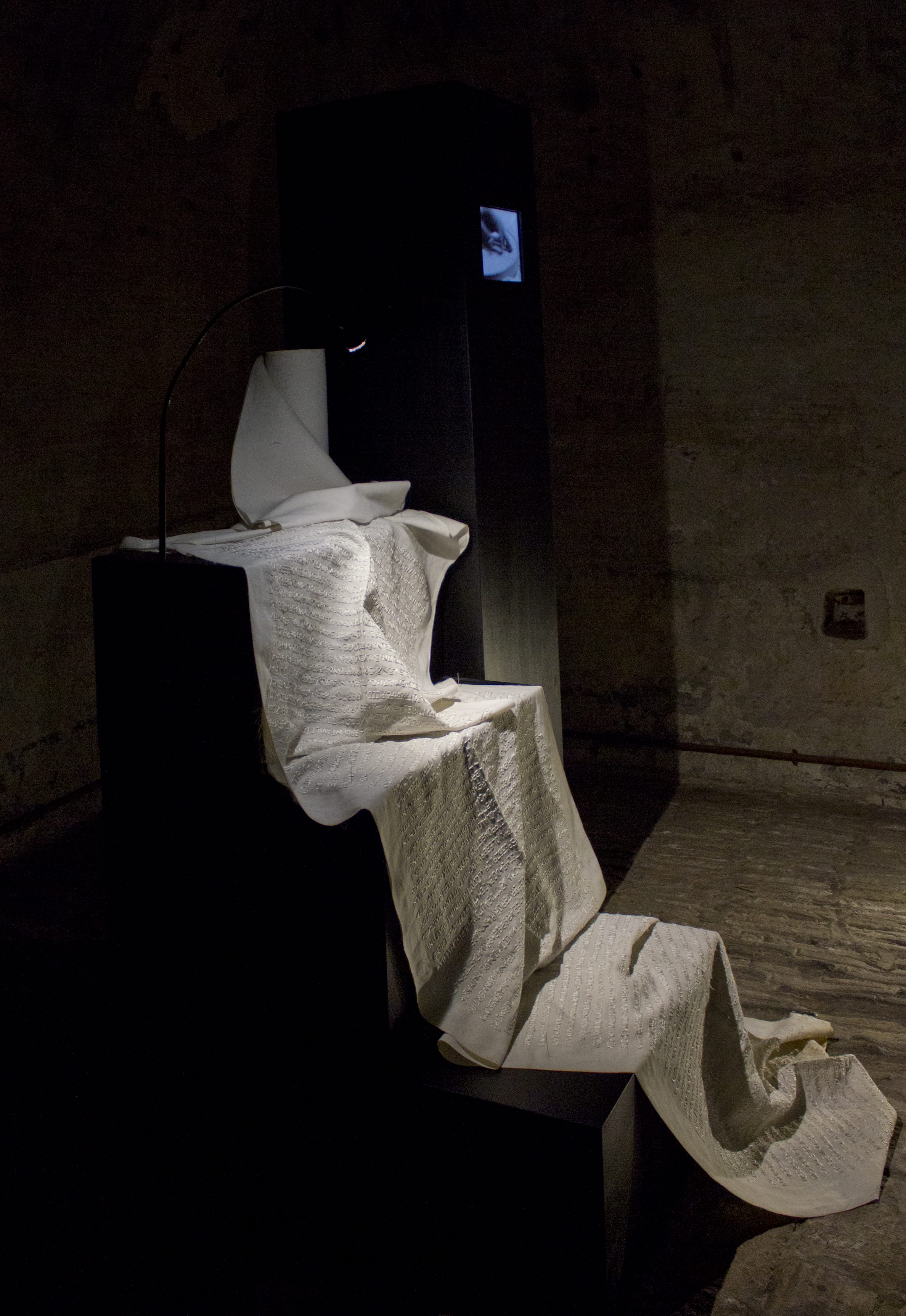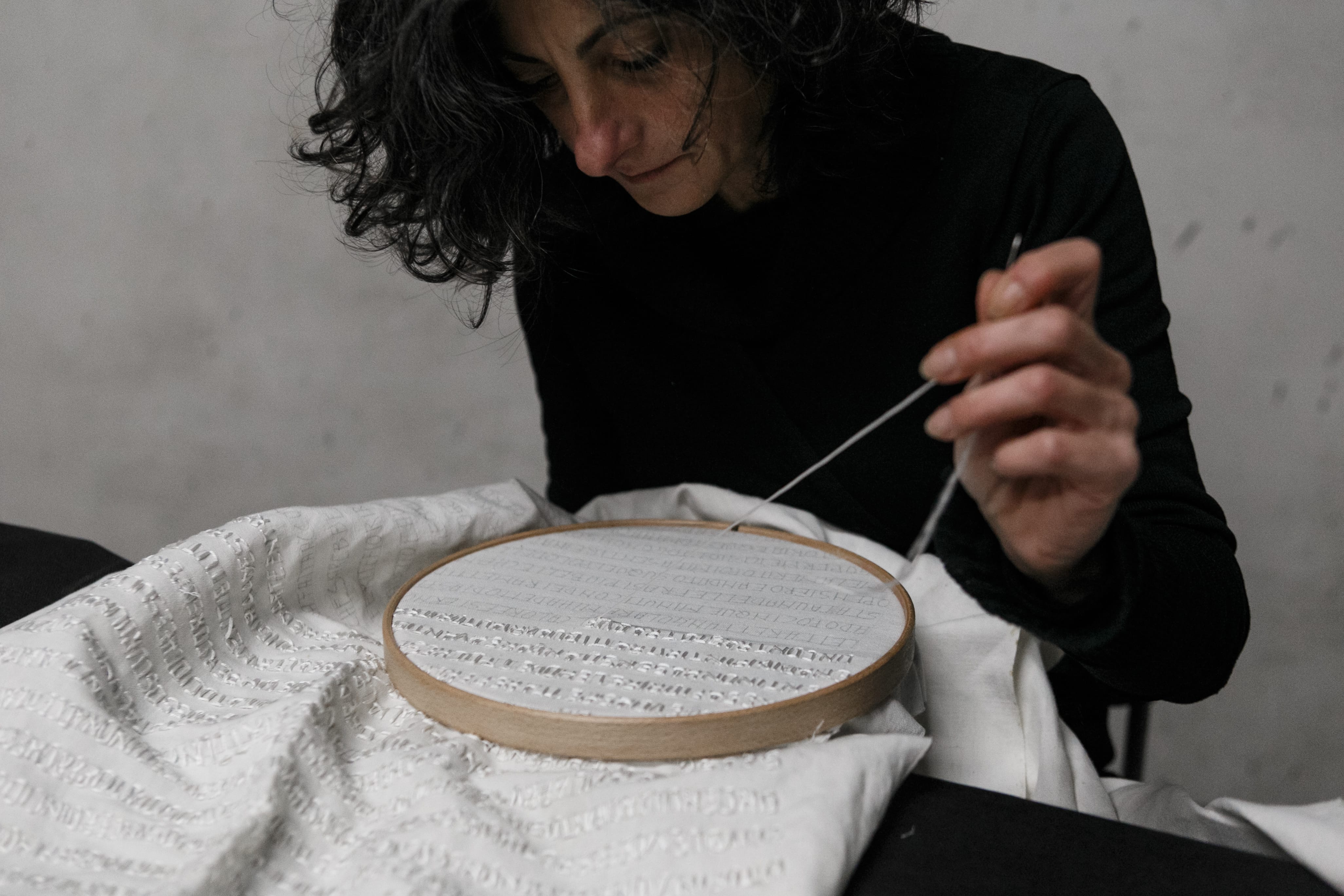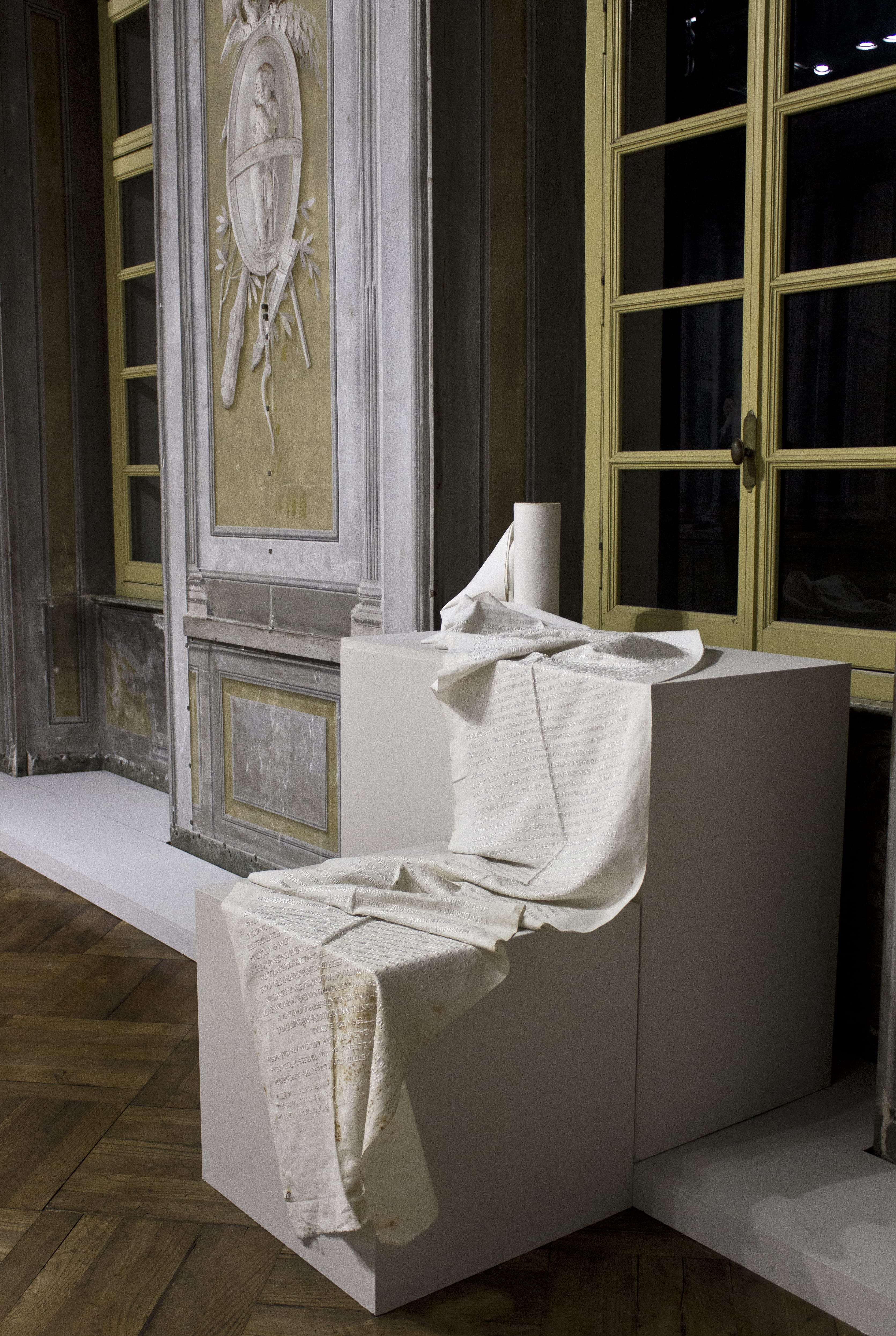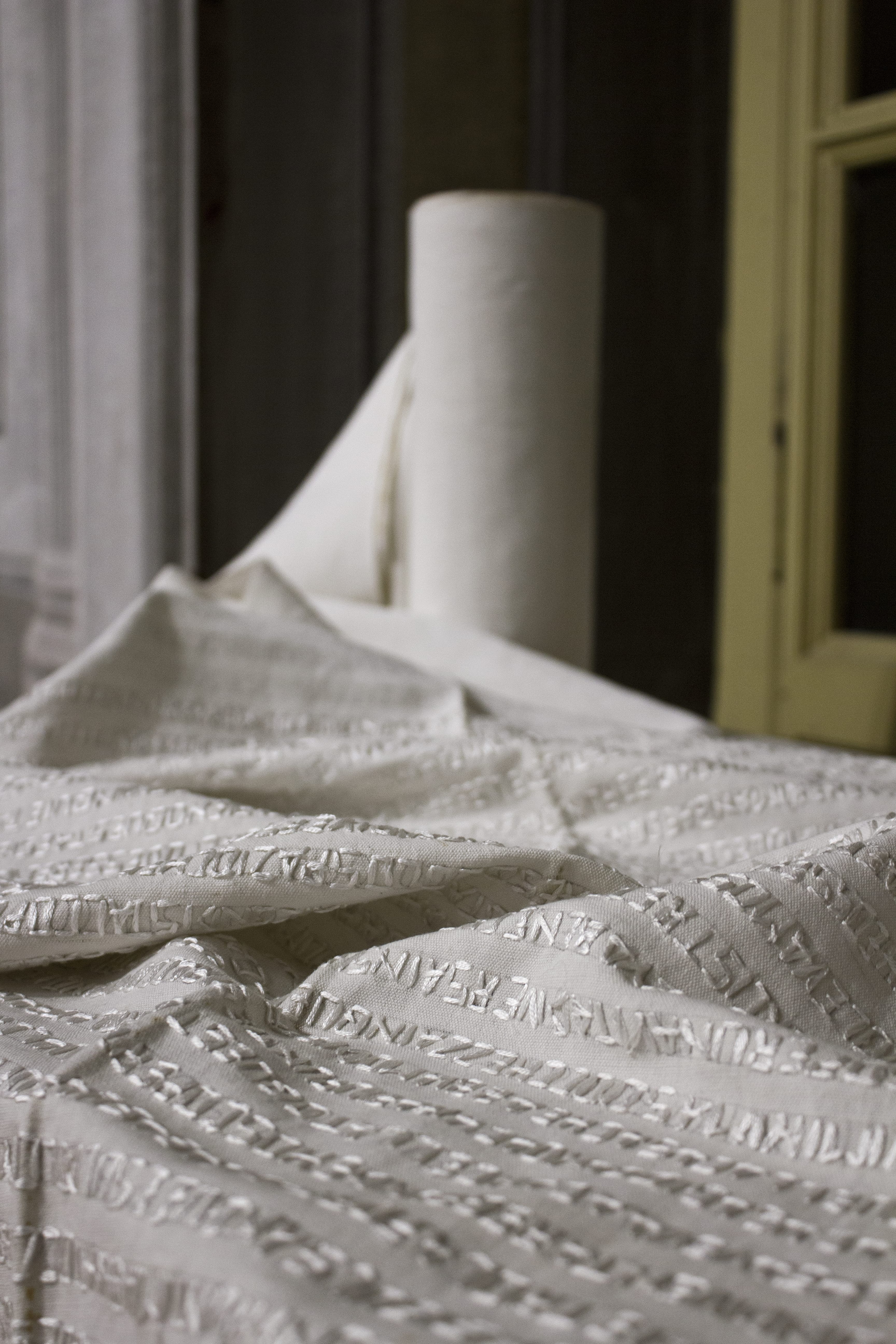Interview with Ilaria Margutti
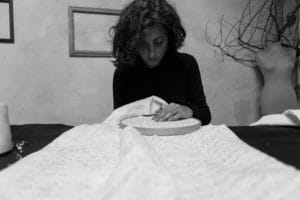
Ilaria Margutti, artist and teacher of drawing and art history, lives and works in Sansepolcro. Graduated from the Academy of Fine Arts in Florence, she has exhibited her work in many exhibitions in Italy and abroad and has collaborated with various private art galleries.
Since 2007, thanks to the meeting with the embroidery teacher Rosalba Pepi, the artist began to include this technique in his paintings and this is a key moment for his artistic career. The embroidery will allow her to fully express her poetics.
Ilaria has also dedicated herself to projects for the diffusion of contemporary art and has curated “Incontri al Museo con l’ArteContemporanea”, a series of talks and exhibitions with Italian artists, for a project in collaboration with the Museo Civico di Sansepolcro.
For some years now, together with Laura Caruso, she has been in charge of the CASERMARCHEOLOGICA space for Contemporary Art, a project linked to the recovery and reuse of Palazzo Muglioni, the former Carabinieri barracks in Sansepolcro.
Ilaria, why is your choice of artist aimed precisely at textiles as an expressive medium?
Can you tell us something about your history as an artist?
It is a question to which each time I have to answer in a different way, because the time that flows through my life, constantly transforms the way I look at the past and what I thought was important, now it is not. Over the years I have enriched myself with incredible experiences, which I could never have imagined before that I could add to my story.
The dynamics of life need time to be understood and sometimes they take so long to arouse a great wonder when the time comes for (re)discovery, and I am amazed every time, almost like a child.
At first I followed an unknown feeling, I felt that there were things I wanted to understand and learn to know; then this feeling was focused on an identity, that of feeling like an artist; today, to tell the truth, I no longer know what it means to be an artist, I just feel like doing something I love, like when I started, with the only difference that I feel more aware of my identity.
My studies have always been addressed to artistic disciplines and I have woven a real set of things that I love: I teach Art History at the Scientific high school and I keep my artistic research alive, “sewing” these two “places” within a space that connects my students with the world of art (Casermarcheologica).
Among your textile works, which one is the one that represents you most and to which you feel most attached?
The works mark the stages of life.
Every work, or together of them, is a point of arrival and beginning, it is an awareness reached that opens the way to other research.
Until a year ago the work that particularly represented me was a canvas that no longer exists today, because it was damaged due to the carelessness of two cultural operators who allowed her to take the mold by exposing it in an unhealthy place.
That work has taken on another meaning, it has given another form to my creative process and today there are other questions that I ask myself, I have already changed my direction.
Even though I still feel a deep pain for that loss (it was one of the fundamental works of my path at the time), I thought that the investigation I was working on needed more time to be crossed more deeply.
Can you tell us about the series Recto/Verso? What does the back of the canvas represent for you?
How fascinating is the back of the canvas?
It is that part of the work that I cannot dominate, because it is created in the wake of what I rationally go to do.
What happens behind the canvas is another story, another map that draws unexpected territories!
My need was to give life to what is most invisible around us. Even more invisible, unthinkable, because usually what is behind the canvas, you tend to hide it.
Instead, it’s in the error, in the imperfection that the most fertile places of creation are hidden, and in this, the theories of physics have also come to my aid.
(I’m thinking of Guido Tonelli’s book “La nascita imperfetta delle cose”)
There is a quote that I love to use in this situation, the physicist John David Brown writes in his book “The Theories of Everything”.
“Nature is a beautiful tapestry, of which we can only see the back and, looking at its slow threads, we try to understand the drawing in front of us”.
In your opinion, is the technique or the idea more important? What do you think determines the success of an artwork?
I think that the success of an artwork is exclusively linked to what the artist thinks he has achieved with the work itself and not to what the public recognizes in it.
I think there is only one way to define whether a work is good or mediocre and this depends on how the artist has been able to investigate the subject and at what depth he has managed to penetrate it, how much he had dirty his hands, how much he has been transformed and put into play in penetrating the unknown that he has chosen to cross.
This is recognizable by everyone, regardless of their personal tastes: if a work is true, it transforms us.
As for the first part of your question, which would require a much more complex reflection, I would be more inclined to say that the idea does not exist, but there is a path, a journey of knowledge, an experience, a vital symptom of exploration, of investigation to expand its boundaries.
I don’t think that there is a wrong or more right direction than others, I just think that the technique is a tool that is refined to give way to our investigation to arrive in the most remote depths of the journey.
Improvisation, randomness, experimentation, study, rules, design. Which of these aspects has an essential or prevailing role in the process of the birth of your work?
I need everything.
Surely I start from a need for investigation, from a question that becomes a project to give order to the thoughts, then I move on to the experimentation that is the basis, because by experimenting you make mistakes and you discover.
Randomness is therefore a component of experimentation, but then it becomes the form of thought.
It would seem a recipe, or maybe it is, then everyone adds the ingredients they prefer and that choose while experimenting
You use color prudently in your work. Can you explain the reasons for your choice?
Yes, I am afraid that my artworks will become rainbows.
I have nothing against rainbows, let alone.
When I was painting, before dedicating myself to embroidery, my paintings were very expressive and the colour and the pictorial material prevailed over everything.
Now I need cleanliness, the invisible, the transcendent. It is as if I wanted to clean my eyes of all this visual “dirt” that in the social era is polluting our eyes, compressing and paralyzing us… Often I am tempted to embroider only white on white, or to use the light tones of the natural… but I realize that I am still very attached to the figure, to the sinuous and soft forms of the ramifications that expand beyond the confines of the body, to blood as an element of the flow of life …
What does the “embroidery gesture” mean to you, which I believe plays an essential role in your works, not only as a technique of choice, but precisely because of the concept to which it refers?
As I mentioned before, my training comes from painting, which until 2007 I thought was my primary direction and my means of investigation.
Then I met an embroidery teacher who allowed me to change my point of view and overturn all my convictions.
I started again and learned to embroider, but only enough not to be an expert of cross stitch, rather to allow me to distort the traditional stitches and create my own stylistic code that was in tune with my journey of knowledge (*me back to the discourse on the technique I did more above).
Embroidery made me discover a new dimension of the creative act and this discovery influenced the path, diverting it in other directions.
The time, the rhythm, the narration, the breath, the ritual.
All this is reunited in the silence of the thread that flows between the fingers and the fabric. It is a reconciliation that removes a veil from the eyes and then another and yet another, as I perform and conclude a work, many works.
The need to rediscover this dimension pushes me to continue asking myself questions that create other directions in my “work”. Maria Lai, an artist I have always loved, says something beautiful:
Art does not give answers, but indicates directions.
Here is that eternal desire to find oneself suspended between earth and sky, between rhythm and time, between myth and history, in that labyrinth from which Theseus came out, leaving Ariadne on the shores of the island of Naxos, in love and alone.
That dense void that is slowly built, in silence and pain, that intertwines and unfolds in every direction to generate life. In here I get lost and I find myself every time I sit in front of my loom and I stay still for hours embroidering.
Ilaria, what is the purpose of your work? Let me explain myself better. What is the message, the concept or the particular content that you convey through your works, the materials you use and the subjects you choose?
Life, the sense of beauty, the invisible.
The message is the process of investigation that I launch to myself, that someone catches and someone else doesn’t.
Is it important, in your opinion, that the spectator understands the meanings that the artist wants to convey with his works? Are you more interested in “being understood” as an artist or are you also interested in discovering what are the contents of the (absolutely personal) experience that your audience makes in front of your work of art (maybe even distancing itself a lot from your message)?
This is a delicate question, but I try to answer it hoping not to be misunderstood.
The work is the final product of an investigation that the artist carries out exploring within a need of his, what happens before is a process of awareness and experimentation that the public does not see, is the invisible that hides behind an intense work that can not be explained if not living it in the first person.
If the viewer makes the effort not to stop at the surface of the image, but to listen, then he will recognize something that belongs to the work, something that belongs to the artist and maybe see things that the artist himself had not thought, but this depends on the personal experience of each of us.
The richer our eyes are, the more they are used to investigating and the more they will be able to read what lies behind the work.
If this does not happen, then it happens that the work can be misunderstood and distorted.
Surely the artist cannot prevent the viewer of his work from seeing things that he did not want to say, but there is a way of looking and listening.
In this era of post truths, fake news, and compulsive and derogatory answers that every day are thrown into social networks, are we sure we are trained enough to listen, to the look and to the dimension of silence?
I think not, or not enough, because it is tiring, more tiring than any story can ever tell us.
Can you tell us about the “Casermarcheological” project? How was it born and how is it developing?
This is a story that I live like one of my weavings, but it is happening in a place that is made of people, relationships, friendships, art and territory.
CasermArcheologica and is a process of urban regeneration that began in 2013.
It is an abandoned place in the middle of the historic center of Sansepolcro next to the Civic Museum in which is preserved the Resurrection of Piero della Francesca, a sixteenth-century palace belonged to a noble family “biturgense”, now completely disappeared.
Together with some of my students of the time, we spent the Easter holidays cleaning the halls of the palace from dust and rubble.
Since then I have not been able to leave that building and, in 2016, thanks to the professional contribution of my colleague and friend Laura Caruso, we won the Bando Culturability, funded by the Unipolis Foundation, which allowed us to continue to carry on this beautiful energy that had developed spontaneously, from below, by citizens, people and my young students.
Today Casermarcheologica is:
- the first exhibition and workshop space in Valtiberina dedicated to the languages of contemporary arts, through co-creation paths shared with artists, young people and cultural professionals of the territory, in continuous exchange with the citizens.
- A co-working, dedicated to young professionals who can have a workplace in a context of collaboration and project support.
- Training, continuous and permanent, to introduce new skills and to promote a fruitful exchange of knowledge.
In this context, Casermarcheologica has been selected among the various realities of regeneration of the internal areas of the Apennines by Mario Cucinella, within the Italian Archipelago, for the sixteenth Biennale of Architecture in Venice in the Italian Pavilion. A very important goal for us, because it shows us that the direction we have taken is the right one.
I like to think that this project is very similar to my work as a textile artist, because even Caserma is held together by a thread that intertwines with time, life, people and the narrative.
Can you tell us about your “Il filo dell’imperfetto”(The Thread of the Imperfect) series? These are works from about ten years ago. How has your work changed since then?
Imperfection is what makes us unique, exclusive and above all allows us to reflect on ourselves, starting from that breaking point that makes us imperfect.
In that series I metaphorically mended the wounds of other people.
I met, talked and shared a pain with the subjects I portrayed in this series and through their experience, we have completed together a path of healing.
The scars have therefore become lace, precious darning that unravels on the skin/canvas and shows itself fearlessly to the viewer’s gaze.
The thread reminds us that pain can be transformed and that beauty is hidden within a complex and invisible process of crossing lived deeply, to the end.
The thread mends and teaches waiting.
It is not easy to listen and be crossed by the pain of others, I remember that after the interviews I needed time to decompression because some stories were really very strong, but when I started to embroider those wounds, I felt that I was transforming myself, I was identifying myself and at the same time I detached myself so as not to be crushed by all that responsibility to feel like the guardian of a pain of others.
When they tell me that my works are painful and distressing, I answer that they do not speak of pain, but of healing and if one sees pain in them, it means that he must himself heal from something that he has not been able to overcome until the end.
Today my work is following a different direction, I try to leave more and more space to the invisible.
That’s why I’m interested in the back of the canvas, the writing, sometimes the performance and I’m eliminating more and more the color.
What are you working on right now?
The last work I did was entitled “Sühne” for the exhibition “Segrete, tracce di Memoria” curated by Virginia Monteverde at the prisons of Palazzo Ducale in Genoa, in which I hand-embroidered 250 cm of writing on an antique sheet.
The embroidery I made is partly the result of a performance I gave in Casermarcheologica for three consecutive weeks, in which every day I went for about three hours to embroider pieces of diaries of people dear to me.
At the end of the three weeks I had embroidered 150 cm of fabric, practically 10 cm a day.
I wanted to dedicate this work to Etty Hillesum, who in the two years before moving to Auschwitz concentration camp, managed to write a diary of profoundly intense beauty.
It is a diary in which Etty, manages to narrate herself so as not to let her be taken away even her most human, intimate and profound part, increasingly cancelled every day by the devastation of what she lived in imprisonment as a deportee.
A hymn to life, which teaches us how important it is to defend the invisible of the things that are in us.
For further information: https://www.ilariamargutti.com/works/suhne/
Galleria immagini
FOTO 1: “Maria’sMend II”, 100×100, 2009,copyright Ilaria Margutti
FOTO 2: “Maria’sMend II”,100×100, 2009,copyright Ilaria Margutti
FOTO 3: “Maria’sMend”, dettaglio, 100×100, 2009,copyright Ilaria Margutti
FOTO 4: “Sühne”, 250cm di scrittura ricamata su lenzuolo antico, 2019, copyright Ilaria Margutti
FOTO 5: L’artista ritratta durante la performance relativa alla sua opera “Sühne”
FOTO 6: “Fioritura estrema (trasformare)”, 2018,copyright Ilaria Margutti
FOTO 7: “Fioritura estrema (trasformare)”, dettaglio,2018, copyright Ilaria Margutti
FOTO 8: “Sühne”, opera in esposizione alla Mostra ContemporaneAdi Biella, 2018
FOTO 9: “Sühne”, opera in esposizione alla Mostra ContemporaneAdi Biella, 2018
